
- ELEMENTARY TEACHING , INTEGRATED CURRICULUM ACTIVITIES

Animal Research Project for Kids at the Elementary Level in 2024
Whether you are doing a simple animal study or a fully integrated science, reading, and writing unit, this animal research project for kids includes everything you need. From the graphic organizer worksheets and guided note templates to the writing stationary, printable activities, projects, and rubrics.
Thousands of teachers have used this 5-star resource to have students complete self-guided animal research projects to learn about any animal they choose. The best part is, the resource can be used over and over again all year long by just picking a new animal! Learn all about this animal research project for kids at the elementary level below!

What is the Animal Research Project?
The animal research project is a resource that is packed with printable and digital activities and projects to choose from. It is perfect for elementary teachers doing a simple animal study or a month-long, fully integrated unit. It’s open-ended nature allows it to be used over and over again throughout the school year. In addition, it includes tons of differentiated materials so you can continue to use it even if you change grade levels. Learn about what’s included in it below!
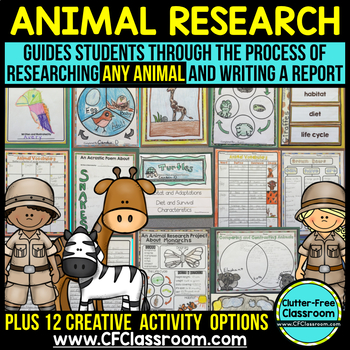
What is Included in the Animal Research Project
The following resources are included in the animal research project :
Teacher’s Guide
The teacher’s guide includes tips and instructions to support you with your lesson planning and delivery.
Parent Letter
The parent communication letter promotes family involvement.
Graphic Organizers
There are graphic organizers for brainstorming a topic, activating schema, taking notes, and drafting writing.
Research Report
There are research report publishing printables including a cover, writing templates, and resource pages.
There is a grading rubric so expectations are clear for students and grading is quick and easy for you.
Research Activities
The research activities include a KWL chart, can have are chart, compare and contrast venn diagram, habitat map, vocabulary pages, illustration page, and life cycle charts.
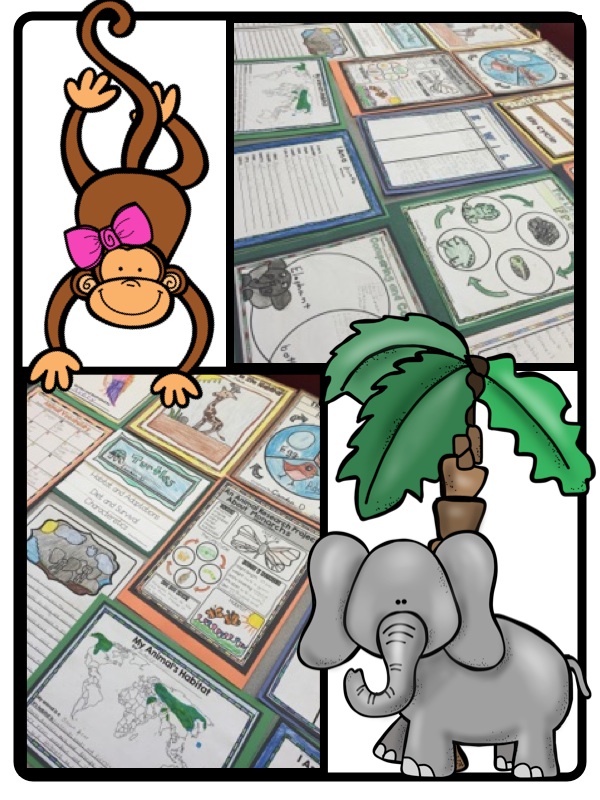
Animal Flip Book Project
There are animal flip book project printables to give an additional choice of how students can demonstrate their understanding.
Animal Flap Book Project
There is an animal flap book project printables that offers students yet another way to demonstrate their learning.
Animal Research Poster
The animal research poster serves as an additional way to demonstrate student understanding.
Poetry Activities
The resource includes poetry activities to offer students an alternative way to demonstrate their learning.
Digital Versions
There is a digital version of the resource so your students can access this resource in school or at home.
Why Teachers love the Animal Research Project
Teachers love this animal research project because of the following reasons:
- This resource guides students through the research and writing process, so they can confidently work their way through this project.
- It is a great value because it can be used over and over again throughout the school year because the pages can be used to learn about any animal.
- It offers several ways students can demonstrate their learning.
- It includes a ton of resources, so you can pick and choose which ones work best for you and your students.
- It is printable and digital so it can be used for in-class and at-home learning.
This animal research packet is great because it can be used over and over again using absolutely any animal at all. The printables in this packet are ideal to use with your entire class in school, as an at-home learning extension project or as a purposeful, open-ended, independent choice for your students who often finish early and need an enrichment activity that is so much more than “busy work.”
The Research Report Process
This animal research project packet was designed in a manner that allows you to use all of the components when studying any animal. Because the printables can be used over and over, I will often work through the entire researching and writing process with the whole class focusing on one animal together, This allows me to model the procedure and provide them with support as they “get their feet wet” as researchers. Afterwards I then have them work through the process with an animal of choice. You may find it helpful to have them select from a specific category (i.e. ocean animals, rainforest animals, etc) as this will help to streamline the resources you’ll need to obtain.
Step 1: Brainstorm a list of animals to research. Select one animal.
During this stage you may want to provide the students with a collection of books and magazines to explore and help them narrow down their choice.
Step 2: Set a purpose and activate schema.
Students share why they selected the animal and tell what they already know about it. Next, they generate a list of things they are wondering about the animal. This will help to guide their research.
Step 3: Send home the family letter.
To save you time, involve families, and communicate what is happening in the classroom, you may want to send home a copy of the family letter. It’s so helpful when they send in additional research materials for the students.
Step 4: Research and take notes.
The two-column notes template is a research-based tool that helps the kids organize their notes. I added bulleted prompts to guide the students in finding specific information within each category. This method has proven to be highly effective with all students, but is especially useful with writers who need extra support.
I have included two versions of the organizers (with and without lines). I print a copy of the organizer for each student. I also copy the lined paper back to back so it is available to students who need more space.
Step 5: Write a draft.
Using the information gathered through the research process, the students next compose drafts. The draft papers were designed to guide the students through their writing by providing prompts in the form of questions. Answering these questions in complete sentences will result in strong paragraphs. It may be helpful to give them only one page at a time instead of a packet as it make the task more manageable.
Step 6: Edit the draft.
Editing can be done in many ways, but it is most effective when a qualified editor sits 1:1 with a student to provides effective feedback to them while editing.
Step 7: Publish.
Print several copies of the publishing pages. I like to have all my students start with the page that has a large space for an illustration, but then let them pick the pages they want to use in the order they prefer after that. I have them complete all the writing first and then add the illustrations.
Finally, have the children design a cover for the report. Add that to the front and add the resources citation page to the back. Use the criteria for success scoring rubric to assign a grade. The rubric was designed using a 20 point total so you can simply multiply their score by 5 to obtain a percentage grade. The end result is a beautiful product that showcases their new learning as well as documents their reading and writing skills.
In closing, we hope you found this animal research project for kids helpful! If you did, then you may also be interested in these posts:
- How to Teach Research Skills to Elementary Students
- 15 Animals in Winter Picture Books for Elementary Teachers
- How to Teach Informative Writing at the Elementary Level
You might also like...

Project Based Learning Activities for Elementary Students
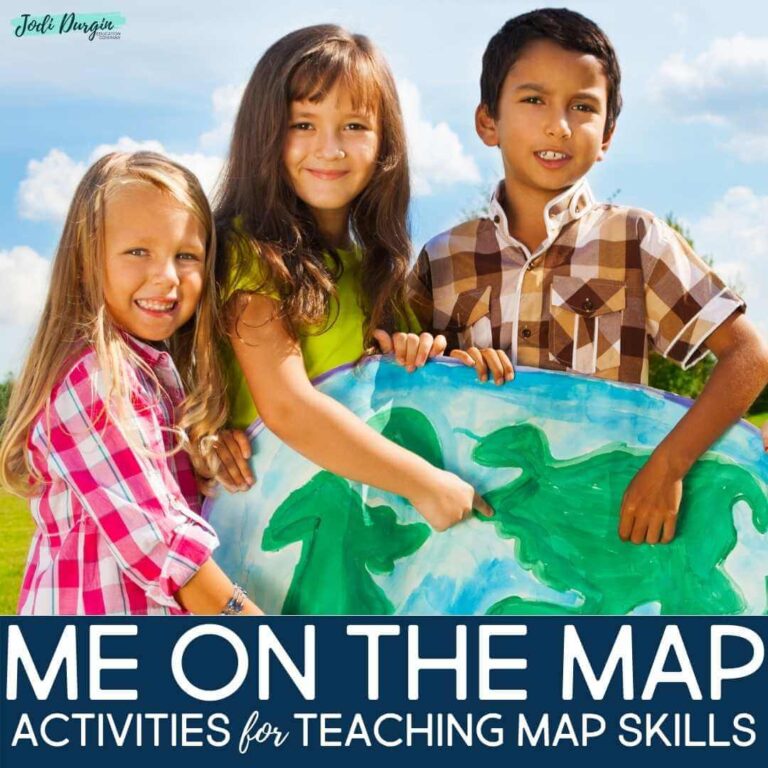
Me on the Map Activities and Printables for Elementary Teachers – 2024

Student-Made Board Games Ideas for Elementary Teachers in 2024
Join the newsletter.

- CLUTTER-FREE TEACHER CLUB
- FACEBOOK GROUPS
- EMAIL COMMUNITY
- OUR TEACHER STORE
- ALL-ACCESS MEMBERSHIPS
- OUR TPT SHOP
- JODI & COMPANY
- TERMS OF USE
- Privacy Policy
Sorry, it looks like you have JavaScript disabled. Learn how to enable it.
Research using animals: an overview
Around half the diseases in the world have no treatment. Understanding how the body works and how diseases progress, and finding cures, vaccines or treatments, can take many years of painstaking work using a wide range of research techniques. There is overwhelming scientific consensus worldwide that some research using animals is still essential for medical progress.
Animal research in the UK is strictly regulated. For more details on the regulations governing research using animals, go to the UK regulations page .
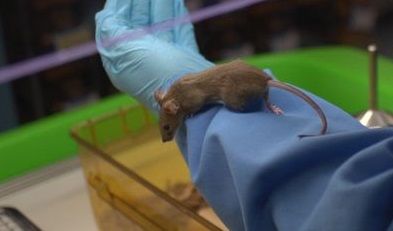
Why is animal research necessary?
There is overwhelming scientific consensus worldwide that some animals are still needed in order to make medical progress.
Where animals are used in research projects, they are used as part of a range of scientific techniques. These might include human trials, computer modelling, cell culture, statistical techniques, and others. Animals are only used for parts of research where no other techniques can deliver the answer.
A living body is an extraordinarily complex system. You cannot reproduce a beating heart in a test tube or a stroke on a computer. While we know a lot about how a living body works, there is an enormous amount we simply don’t know: the interaction between all the different parts of a living system, from molecules to cells to systems like respiration and circulation, is incredibly complex. Even if we knew how every element worked and interacted with every other element, which we are a long way from understanding, a computer hasn’t been invented that has the power to reproduce all of those complex interactions - while clearly you cannot reproduce them all in a test tube.
While humans are used extensively in Oxford research, there are some things which it is ethically unacceptable to use humans for. There are also variables which you can control in a mouse (like diet, housing, clean air, humidity, temperature, and genetic makeup) that you could not control in human subjects.
Is it morally right to use animals for research?
Most people believe that in order to achieve medical progress that will save and improve lives, perhaps millions of lives, limited and very strictly regulated animal use is justified. That belief is reflected in the law, which allows for animal research only under specific circumstances, and which sets out strict regulations on the use and care of animals. It is right that this continues to be something society discusses and debates, but there has to be an understanding that without animals we can only make very limited progress against diseases like cancer, heart attack, stroke, diabetes, and HIV.
It’s worth noting that animal research benefits animals too: more than half the drugs used by vets were developed originally for human medicine.
Aren’t animals too different from humans to tell us anything useful?
No. Just by being very complex living, moving organisms they share a huge amount of similarities with humans. Humans and other animals have much more in common than they have differences. Mice share over 90% of their genes with humans. A mouse has the same organs as a human, in the same places, doing the same things. Most of their basic chemistry, cell structure and bodily organisation are the same as ours. Fish and tadpoles share enough characteristics with humans to make them very useful in research. Even flies and worms are used in research extensively and have led to research breakthroughs (though these species are not regulated by the Home Office and are not in the Biomedical Sciences Building).
What does research using animals actually involve?
The sorts of procedures research animals undergo vary, depending on the research. Breeding a genetically modified mouse counts as a procedure and this represents a large proportion of all procedures carried out. So does having an MRI (magnetic resonance imaging) scan, something which is painless and which humans undergo for health checks. In some circumstances, being trained to go through a maze or being trained at a computer game also counts as a procedure. Taking blood or receiving medication are minor procedures that many species of animal can be trained to do voluntarily for a food reward. Surgery accounts for only a small minority of procedures. All of these are examples of procedures that go on in Oxford's Biomedical Sciences Building.
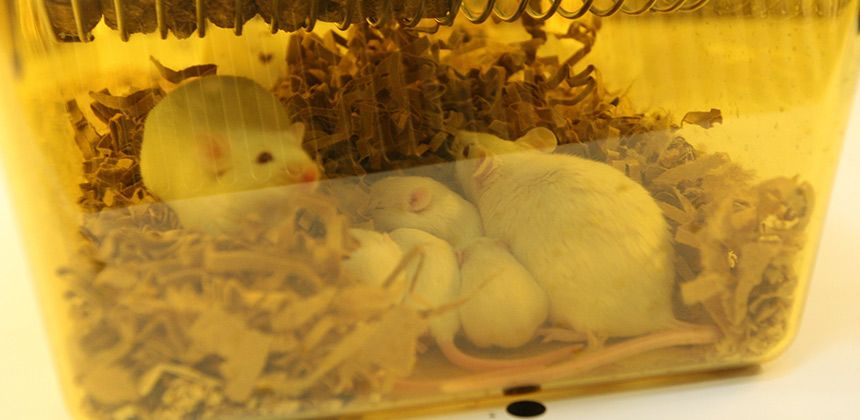
How many animals are used?
Figures for 2023 show numbers of animals that completed procedures, as declared to the Home Office using their five categories for the severity of the procedure.
# NHPs - Non Human Primates
Oxford also maintains breeding colonies to provide animals for use in experiments, reducing the need for unnecessary transportation of animals.
Figures for 2017 show numbers of animals bred for procedures that were killed or died without being used in procedures:
Why must primates be used?
Primates account for under half of one per cent (0.5%) of all animals housed in the Biomedical Sciences Building. They are only used where no other species can deliver the research answer, and we continually seek ways to replace primates with lower orders of animal, to reduce numbers used, and to refine their housing conditions and research procedures to maximise welfare.
However, there are elements of research that can only be carried out using primates because their brains are closer to human brains than mice or rats. They are used at Oxford in vital research into brain diseases like Alzheimer’s and Parkinson’s. Some are used in studies to develop vaccines for HIV and other major infections.
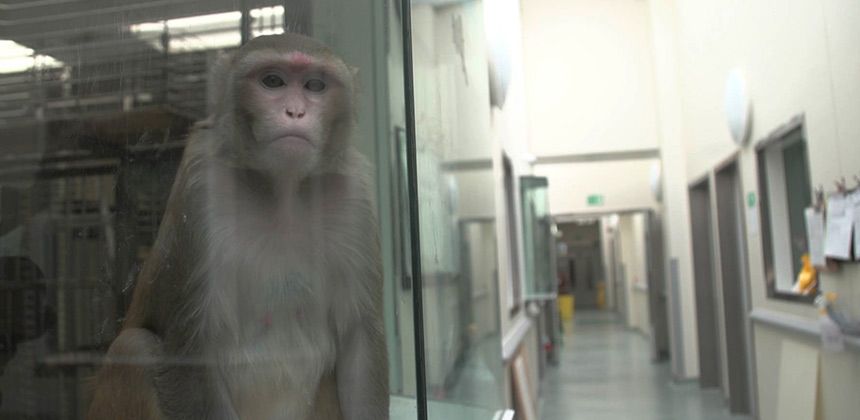
What is done to primates?
The primates at Oxford spend most of their time in their housing. They are housed in groups with access to play areas where they can groom, forage for food, climb and swing.
Primates at Oxford involved in neuroscience studies would typically spend a couple of hours a day doing behavioural work. This is sitting in front of a computer screen doing learning and memory games for food rewards. No suffering is involved and indeed many of the primates appear to find the games stimulating. They come into the transport cage that takes them to the computer room entirely voluntarily.
After some time (a period of months) demonstrating normal learning and memory through the games, a primate would have surgery to remove a very small amount of brain tissue under anaesthetic. A full course of painkillers is given under veterinary guidance in the same way as any human surgical procedure, and the animals are up and about again within hours, and back with their group within a day. The brain damage is minor and unnoticeable in normal behaviour: the animal interacts normally with its group and exhibits the usual natural behaviours. In order to find out about how a disease affects the brain it is not necessary to induce the equivalent of full-blown disease. Indeed, the more specific and minor the brain area affected, the more focussed and valuable the research findings are.
The primate goes back to behavioural testing with the computers and differences in performance, which become apparent through these carefully designed games, are monitored.
At the end of its life the animal is humanely killed and its brain is studied and compared directly with the brains of deceased human patients.
Primates at Oxford involved in vaccine studies would simply have a vaccination and then have monthly blood samples taken.
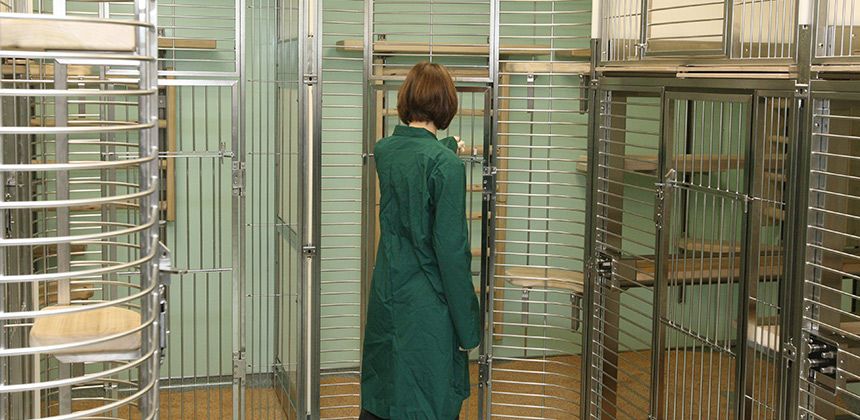
How many primates does Oxford hold?
* From 2014 the Home Office changed the way in which animals/ procedures were counted. Figures up to and including 2013 were recorded when procedures began. Figures from 2014 are recorded when procedures end.
What’s the difference between ‘total held’ and ‘on procedure’?
Primates (macaques) at Oxford would typically spend a couple of hours a day doing behavioural work, sitting in front of a computer screen doing learning and memory games for food rewards. This is non-invasive and done voluntarily for food rewards and does not count as a procedure. After some time (a period of months) demonstrating normal learning and memory through the games, a primate would have surgery under anaesthetic to remove a very small amount of brain tissue. The primate quickly returns to behavioural testing with the computers, and differences in performance, which become apparent through these carefully designed puzzles, are monitored. A primate which has had this surgery is counted as ‘on procedure’. Both stages are essential for research into understanding brain function which is necessary to develop treatments for conditions including Alzheimer’s, Parkinson’s and schizophrenia.
Why has the overall number held gone down?
Numbers vary year on year depending on the research that is currently undertaken. In general, the University is committed to reducing, replacing and refining animal research.
You say primates account for under 0.5% of animals, so that means you have at least 16,000 animals in the Biomedical Sciences Building in total - is that right?
Numbers change daily so we cannot give a fixed figure, but it is in that order.
Aren’t there alternative research methods?
There are very many non-animal research methods, all of which are used at the University of Oxford and many of which were pioneered here. These include research using humans; computer models and simulations; cell cultures and other in vitro work; statistical modelling; and large-scale epidemiology. Every research project which uses animals will also use other research methods in addition. Wherever possible non-animal research methods are used. For many projects, of course, this will mean no animals are needed at all. For others, there will be an element of the research which is essential for medical progress and for which there is no alternative means of getting the relevant information.
How have humans benefited from research using animals?
As the Department of Health states, research on animals has contributed to almost every medical advance of the last century.
Without animal research, medicine as we know it today wouldn't exist. It has enabled us to find treatments for cancer, antibiotics for infections (which were developed in Oxford laboratories), vaccines to prevent some of the most deadly and debilitating viruses, and surgery for injuries, illnesses and deformities.
Life expectancy in this country has increased, on average, by almost three months for every year of the past century. Within the living memory of many people diseases such as polio, tuberculosis, leukaemia and diphtheria killed or crippled thousands every year. But now, doctors are able to prevent or treat many more diseases or carry out life-saving operations - all thanks to research which at some stage involved animals.
Each year, millions of people in the UK benefit from treatments that have been developed and tested on animals. Animals have been used for the development of blood transfusions, insulin for diabetes, anaesthetics, anticoagulants, antibiotics, heart and lung machines for open heart surgery, hip replacement surgery, transplantation, high blood pressure medication, replacement heart valves, chemotherapy for leukaemia and life support systems for premature babies. More than 50 million prescriptions are written annually for antibiotics.
We may have used animals in the past to develop medical treatments, but are they really needed in the 21st century?
Yes. While we are committed to reducing, replacing and refining animal research as new techniques make it possible to reduce the number of animals needed, there is overwhelming scientific consensus worldwide that some research using animals is still essential for medical progress. It only forms one element of a whole research programme which will use a range of other techniques to find out whatever possible without animals. Animals would be used for a specific element of the research that cannot be conducted in any alternative way.
How will humans benefit in future?
The development of drugs and medical technologies that help to reduce suffering among humans and animals depends on the carefully regulated use of animals for research. In the 21st century scientists are continuing to work on treatments for cancer, stroke, heart disease, HIV, malaria, tuberculosis, diabetes, neurodegenerative diseases like Alzheimer's and Parkinson’s, and very many more diseases that cause suffering and death. Genetically modified mice play a crucial role in future medical progress as understanding of how genes are involved in illness is constantly increasing.
A Virtual Animal Behavior Research Project for an Introductory Biology Course
In December 2019, I was preparing to teach the lab section for the second half of an introductory biology sequence, which includes evolution, form and function, and ecology. I’d taught this course many times in the past, though I hadn’t for a few years before 2019. I knew I wanted to move away from rote learning through memorization or canned laboratory activities, and to create an authentic experience that would allow me the overarching theme of developing students’ scientific skills, as well as their science identity. Therefore, I redesigned the course so that our scheduled lab time was used for knowledge and skill development. The course focused on the research skills in the Vision and Change Biology Core Concepts (AAAS 2011) and supporting literature outlining how to apply the core concepts (Branchaw et al. 2020) so that students developed the necessary skills to conduct the research project at the end of the course.
Unfortunately, my initial plans were sidelined by the ongoing global pandemic, which required a portion of our laboratory activities to be conducted virtually. I ended up developing a multiweek virtual model to develop basic scientific knowledge and skills using BioInteractive resources that culminated in an eight-week-long animal behavior research project.
In developing this course, I focused on skill development because it’s essential for building confidence. When students are more confident in their skills, this confidence generates a sense of belonging in science, contributing to their science identity. This is essential for retention of students identified historically as Persons Excluded because of their Ethnicity or Race (PEERs), who may be marginalized and less comfortable in the science environment (Asai 2020).
Ethogram and Time-Budget Study
In order to move students toward more open-ended experiments, I chose ethograms with a time-budget study as their final research project. Ethograms are used in the field of animal behavior to collect data during observations and require making a series of field observations that result in a catalog of behaviors and activities identified by the observer.
For this research project, students conducted independent ethological research observing the behavior of an animal species of their choice. I asked students to choose between focusing on a group of animals or an individual, since these require different observational techniques. In observing a group of animals via webcam, students needed to understand that they should focus on one individual of the group for set intervals. Students could also choose to focus on an individual animal for longer and more frequent observations, though that comes with its own limitations.
Initial observations of specific behaviors helped students construct their data-collection instruments, which are used to construct a basic ethogram. Students determined how they would collect data, which helped to develop observational skills and rudimentary experimental design. I provided students with some examples of ethogram templates. (Many zoos have a basic version posted for students, such as this one: Virtual Classroom | Animal Ethograms - Denver Zoo .)
Finally, students used the list of behaviors they collected for their ethogram to observe their animal(s) several more times. They were required to create a data-collection tool to record the number of times each behavior was observed during a specified period of time for at least three more observation periods. These data were used to create a time-budget study, which is a study that identifies the activities an animal is performing in order to determine how the animal uses its energy during a specific time period.
Overall, ethograms and time-budget studies ease students into research before they are introduced to experimental variables and more advanced research methodology. Plus, it’s fun because they choose their own study animal, so it allows for an authentic final assessment in which students demonstrate the skills they have learned and take ownership of their project.
Weekly Modules
For context, this course consisted of a three-credit lecture and a one-credit lab. The first six weeks of the 15-week laboratory portion were conducted in a synchronous virtual format, using BioInteractive materials to teach the basic skills necessary to start the ethogram project. (The first six weeks, as well as the culminating project description, are presented here.) Starting in Week 7, we also conducted in-person lab activities that enhanced students’ background knowledge on animal behavior and taxonomy. All work for the ethogram project was submitted through the course learning management system.
Week 1: Science Literacy Part 1 & Evaluating Science in the News
The first week of lab class introduced students to the process of science by having them evaluate scientific news articles to prepare them for the literature review of their animal behavior project. During our synchronous meeting time, I provided a minilecture on scientific literacy, pseudoscience, and understanding logical fallacies, followed by a short quiz using an online polling system. I then assigned students into breakout groups. Each team completed the short handout for the activity “Evaluating Science in the News,” which involves using the CRAP (Currency, Reliability, Authority, and Purpose) test to evaluate a science news source.
Each team evaluated a “science” article about SARS-CoV-2 that was filled with misinformation by filling out the handout. I assigned the extended version of the “ Scientist Role Models” activity as homework because I wanted them to begin creating their science identity so that they considered themselves as scientists.
Week 2: Scientific Literacy Part 2: Reading Scientific Articles
During Week 2, we continued exploring scientific literacy to scaffold skills they learned in Week 1. The synchronous virtual meeting began with a case study activity that provided students with information about experimental design and basic data analysis. This case study also showed an animal observation study in which there is no laboratory experiment, but data were still collected based on a hypothesis.
We discussed the case study as a class, with students responding in the chat or out loud. Once we completed the case study, I created teams for another article analysis activity. We used this activity to become familiar with the structure of a scientific paper and describe what kind of information is provided in each section (abstract, introduction, methods, results, and conclusion). The activity goals were:
- Identify hypotheses in scientific writing.
- Evaluate evidence in support of a claim in scientific and journalistic writing.
- Identify appropriate search terms.
- Effectively search library databases to find relevant peer-reviewed scientific literature.
- Gain experience reviewing peer-reviewed literature.
Here are guiding questions that I asked students to keep in mind when reading a scientific article. (I also provided an optional resource article: “How to (Seriously) Read a Scientific Paper.” )
- What basic research question are the authors trying to answer?
- What makes that research question significant? (That is, why try to answer that question? Why does it matter?)
- What data did the authors collect?
- What is the authors’ interpretation of their data?
- Do you think that the data they collected supports their conclusions? Why or why not?
This activity consisted of two parts:
Part 1: I reviewed how scientists formulate a hypothesis, test it, and share their information with their peers through publication. I briefly introduced a topic using a short video. While students watched the video, I asked them to focus on how an observation, no matter how trivial, could help form a testable scientific question and emphasized that observation is the beginning of all scientific investigations.
I used a video about penguin defecation to maintain the theme of research related to animal observation. It gave students a chuckle, but is related to actual research, which they review in Part 2 of the activity.
Part 2: Students were divided into groups to read an article about penguin defecation ( Meyer-Rochow and Gal 2003 ) related to the research depicted in the video. Students were asked to work as a team to identify various components of the article, including the scientist’s hypothesis, the evidence used to accept or reject the hypothesis, and whether the hypothesis was accepted or rejected. For the activity, students chose one person from their group to be the notetaker and one person to report back to the entire class when we reconvened.
When the groups finished, we reconvened and students shared out. I recommend doing this as a group activity after they watch the video, with a follow-up discussion, because both of my sections found this particularly difficult. The article was a bit complex for them to understand, but as we talked through it, they understood the importance of becoming familiar with primary literature. I also reminded students that they were not expected to fully understand the paper.
Homework for Week 2 consisted of a similar reading assignment that related to the work they would do in Week 4 (Lizard Evolution Lab). Students watched a BioInteractive video on reproductive isolation and speciation in lizards , then read “Rapid evolution of a native species following invasion by a congener” ( Stuart et al. 2014 ).
In the directions for the article analysis, I reminded students that they were working toward a course goal of being able to understand scientific journal articles. I also allayed students’ concerns about the complexity of the article by reassuring them that I would do my best to teach them the background information needed to understand each article before we read it. I also told them to focus their attention on what they wanted to glean from the article.
Week 3: Sampling Distribution Lab
During Week 3, students were introduced to graph analysis and the concept of sample distributions using the Sampling and Normal Distribution Click & Learn and its accompanying worksheet. I converted the worksheet to a Google Form that students could easily fill out and submit online, since they would be working asynchronously. During the synchronous meeting, we did a quick recap of the article that students read for their homework from Week 2. I also showed the annotated summary of the same article entitled “There's a new kid in town” posted on Science in the Classroom .
After the article discussion, I did a minilecture on sampling distribution and how to use the Click & Learn. I then allowed students to work individually or in teams during class time. I stayed online in the virtual classroom so that students could pop in if they had questions for me. This activity proved to be difficult for some students, so I set up individual virtual meetings to go over their questions. No homework was assigned this week as they were working on the activity asynchronously.
Week 4: Lizard Evolution Lab
Week 4 included one of the favorite activities for both of my groups. Like in Week 3, I spent the synchronous meeting time showing students how to use the Lizard Evolution Virtual Lab and its accompanying worksheet. I also showed the related video The Origin of Species: Lizards in an Evolutionary Tree , which helped students understand how the data for the virtual lab were collected. I reminded them that observational skills were key to this research and that this was the research from the article they read in Week 2.
As in Week 3, I converted the worksheet questions into a Google Form. Similarly, no homework was assigned as they worked on this virtual lab asynchronously.
Week 5: Animal Behavior & Communication Part 1
Students were now ready to apply their skills. For Week 5, I used the synchronous time to go over the following topics with students via videos, a minilecture, and exemplars of previous work:
- How to keep a field journal (discussion and examples posted)
- Overview on ethograms and how they are created (videos and examples posted)
- Various types of animal behaviors that can be observed and methods of sampling animal behavior (videos)
I found several good video examples on YouTube and various examples of ethograms, which I also posted in the learning management system.
For homework, students reviewed the materials, then conducted an initial observation of an animal species of their choice. I’ve written about a similar project here: “Teaching Ecology and Animal Behavior in an Online Setting.” These observations helped them decide on the animal species they would like to study.
I also asked them to find at least two peer-reviewed articles about their animal species. I will admit that I was surprised that, at this point, students struggled with understanding what this meant. Many started off with non-peer-reviewed resources, such as encyclopedias and popular websites. I provided feedback on their resources and did not award the points for the assignment until they submitted peer-reviewed articles. In some cases, this took a virtual meeting to discuss this with students.
Week 6: Animal Behavior & Communication Part 2
For Week 6, students were introduced to a more in-depth example of animal observations so they could apply their problem-solving skills, as well as the knowledge we had learned in class thus far. This example really created a deeper understanding of the process of science once students saw how it was done.
For the synchronous class time, we used the How Animals Use Sound to Communicate Click & Learn. Students were provided with a Google Doc version of the accompanying worksheet so they could fill it in as we worked through the Click & Learn. With the class, I clicked through and discussed the “Introduction” slides to provide students with the knowledge base for the activity.
On Slides 3 and 4, students watched a video of the various animal behaviors identified and defined by the researchers. On Slide 3, I played the video and asked students to try to identify which of the auditory signals they observed the animals using. After this, we moved to Slide 4, which has the same video but highlights the auditory signals that students should have observed. This really showed that observational work, especially when there are multiple animals, is difficult.
This example connected with what students should have done during their observations the previous week. The example also assisted them in that week’s homework, which was constructing their data-collection tool. In addition, we discussed how animals use sound to communicate as we continued to watch the videos. This was much more interesting than reading about animal behavior in their textbook!
At this point, students should also have been thinking about the types of behaviors they could have been observing in Week 5. Some opted to redo their initial observation because they realized they did not adequately observe their animal. I loved that this happened because it let them experience the actual process of science in action. In other words, they realized that their original observational skills were not honed and were better able to understand the types of behaviors they should be looking for in their chosen species.
Once we finished the introduction of the Click & Learn, as a class, we worked through the first case study about how elephants communicate across long distances. This case study begins with an introduction to various types of elephant sounds and describes the combination of low- and high-frequency vocalizations used in elephant communication. This is a great thinking exercise that shows students how observational research can be used to develop a quantitative research study.
As homework for this week, students were asked to revise/develop descriptions of the behaviors they had identified. Then, they developed a definition for each behavior and created their data-collection sheet for the time-budget study.
The time-budget study was created by each student based on the list of behaviors they had generated. Once they identified the timeframe (e.g., observing animals for two 15-minute intervals twice per week at a specific time of day) for their observations, they would count how many times the animal presented with each behavior within the time they observed the animal. This is where they would use the ethogram to create a checklist used during the time-budget study observations. They were provided with a detailed instruction sheet for the entire project.
Once students submitted their data-collection table and received feedback from me (either written or via a meeting), they could start collecting data. They were required to collect data on three separate dates.
After Week 6
After working through Weeks 5 and 6, which helped students design their projects, students collected data for the rest of the semester (Weeks 7–14), with at least three separate data-collection periods required for their time-budget study. The final assessment for the course included an oral presentation of their results, as well as a written paper. I created a slide template for them and a sample of a research paper (I used a former student’s paper with permission), as many were not familiar with how to present authentic research.
After Week 6, the students met for in-person lab exercises (we were masked and in full PPE) where we practiced skills they would need to successfully complete their project. For example, they practiced behavioral observation skills via a pill-bug experiment where they made their own hypotheses and tested them.
During these final weeks, I also scheduled time to meet with students in-person to discuss issues with their projects. I tried to highlight the importance of interacting with a mentor (in this case, me) and helped them practice the skills they would use in graduate school or at work.
All but one student out of 30 successfully completed the project. The final presentations were conducted virtually. Students proudly presented their authentic research and clearly showed how they had developed their research skills with this project. I was ecstatic that students were able to accomplish so much during a global pandemic. They were able to get a feel for what it is like to work with a research mentor and develop their own research projects. I really enjoy mentoring students, and this is a perfect way to interact with them and model for them what it is to be mentored and to engage them in the process of science. Through the creation of the student-mentor bond, I was able to help them begin to see themselves as scientists. The seed for the base of their science identity was planted.
American Association for the Advancement of Science. Vision and Change in Undergraduate Biology Education: A Call to Action . Washington, DC: American Association for the Advancement of Science, 2011.
Asai, D. J. “Race Matters.” Cell 181, 4 (2020): 754–757. https://doi.org/10.1016/j.cell.2020.03.044 .
Branchaw, J. L., P. A. Pape-Lindstrom, K. D. Tanner, S. A. Bissonnette, T. L. Cary, B. A. Couch, A. J. Crowe, et al. “Resources for Teaching and Assessing the Vision and Change Biology Core Concepts. CBE—Life Sciences Education 19, 2 (2020): es1. https://doi.org/10.1187/cbe.19-11-0243 .
Meyer-Rochow, V. B., and J. Gal. “Pressures produced when penguins pooh—calculations on avian defaecation.” Polar Biology 27, 1 (2003): 56–58. https://doi.org/10.1007/s00300-003-0563-3 .
Stuart, Y. E., T. S. Campbell, P. A. Hohenlohe, R. G. Reynolds, L. J. Revell, and J. B. Losos. “Rapid evolution of a native species following invasion by a congener.” Science 346, 6208 (2014): 463–466. https://doi.org/10.1126/science.1257008 .
Melissa Haswell is currently the Associate Dean of Science and Mathematics at Delta College in Michigan. Previously, she taught introductory biology and science ethics for a biology majors program, and anatomy and physiology, and pathophysiology for the nursing program at Davenport University, a private university in Michigan. When she’s not focused on working to improve higher education, she enjoys hiking and camping with her husband and Dalmatian, Chloe, as well as reading, cooking, and spending time with their two cats.
Related Articles
Tim Guilfoyle describes how he uses the BioInteractive short film Some Animals Are More Equal than Others and a claim-evidence-reasoning activity to have his students examine Robert Paine's starfish exclusion experiment.
Sheila Smith explains how she uses the "Creating Chains and Webs" BioInteractive activity to teach her students about the direction of energy flow in food chains and webs. She also uses the short film The Guide to introduce the topic.
Jim Clark describes how he uses the Steve Palumbi and Megan Morikawa Scientists at Work short film to demonstrate to his students that science is not always performed indoors at a lab bench.
Customize Your Path
Filters Applied
Customize Your Experience.
Utilize the "Customize Your Path" feature to refine the information displayed in myRESEARCHpath based on your role, project inclusions, sponsor or funding, and management center.
Conduct research with animals
Need assistance with animal research?
Get help with animal research.
Contact the Division of Laboratory Animal Resources (DLAR):
- Phone: 919-684-2797
- Email: [email protected]
Contact the IACUC Office of Animal Welfare Assurance:
- Phone: 919-668-6720
Duke University recognizes and affirms the essential role that research and education involving live animals has in the advancement of biological and medical knowledge. Further, Duke University acknowledges that animals used in biomedical research and education should receive the best possible care and treatment.
This guidance for getting started with an animal research project will be useful to research personnel new to conducting research involving live animals.
Access the following pages for specific guidance on conducting animal research:
Duke animal care and use program entities.
Duke University's Division of Laboratory Animal Resources (DLAR) is a team of highly trained individuals dedicated to the humane care and use of research animals. DLAR is committed to maintaining the highest quality laboratory animal programs and serves as a resource center for investigators. DLAR strives to provide the highest standard of care, resulting in the best possible quality of life for laboratory animals.
Mission Statement:
The mission statement serves as an overall business philosophy and template for generating a strategic vision to accomplish this endeavor.
In that regard, five goals are set forth as the drivers for DLAR:
- Provide quality care for all laboratory animals used at Duke University.
- Serve as a resource center for investigators and administrators on all issues related to laboratory animals.
- Provide quality animal research models for investigators.
- Maintain compliance, in conjunction with Duke's Institutional Animal Care and Use Committee, with all regulatory and accreditation requirements.
- Position Duke University as a leader in laboratory animal science and management.
Duke University's Animal Care and Use program is fully accredited by AAALAC, International. Duke is also registered as a research facility with the US Department of Agriculture in accordance with the Animal Welfare Act and all amendments and holds a Category 1 Assurance with the Public Health Service (through the NIH's Office of Laboratory Animal Welfare).
The Duke Institutional Animal Care and Use Committee (IACUC) is a Committee of scientists, nonscientists, veterinarians, and community members. It has the responsibility of overseeing and routinely evaluating the Duke Animal Care and Use Program. This is achieved through the evaluation of the care, treatment, housing, and use of animals that are under the Duke Animal Care and Use Program. In addition, the IACUC helps certify compliance with regulatory and oversight standards. Duke’s IACUC Chair is Dr. Anna Hampton.
The Office of Animal Welfare Assurance (OAWA) is the administrative unit that helps the IACUC fulfill its institutional, regulatory, and oversight responsibilities. In addition, OAWA provides customer service to all participants of the Duke Animal Care and Use Program.
The Institutional Official is appointed by the President and is the individual who, as a representative of senior administration, bears ultimate responsibility for the Duke Animal Care and Use Program and is responsible for resource planning and ensuring alignment of Program goals with the institution’s mission. Duke’s Institutional Official is Dr. Mary Klotman .
Animal Studies and School Project Ideas
From Science Fair Project Ideas on Mammals to Experiments About Insects
David Williams / EyeEm / Getty Images
- Cell Biology
- Weather & Climate
- B.A., Biology, Emory University
- A.S., Nursing, Chattahoochee Technical College
Animal research is important for understanding various biological processes in animals , humans included. Scientists study animals in order to learn ways for improving their agricultural health, our methods of wildlife preservation, and even the potential for human companionship. These studies also take advantage of certain animal and human similarities to discover new methods for improving human health.
Learning From Animals
Researching animals to improve human health is possible because animal behavior experiments study disease development and transmission as well as animal viruses . Both of these fields of study help researchers to understand how disease interacts between and within animals.
We can also learn about humans by observing normal and abnormal behavior in non-human animals, or behavioral studies. The following animal project ideas help to introduce animal behavioral study in many different species. Be sure to get permission from your instructor before beginning any animal science projects or behavioral experiments, as some science fairs prohibit these. Select a single species of animal to study from each subset, if not specified, for best results.
Amphibian and Fish Project Ideas
- Does temperature affect tadpole growth?
- Do water pH levels affect tadpole growth?
- Does water temperature affect amphibian respiration?
- Does magnetism affect limb regeneration in newts?
- Does water temperature affect fish color?
- Does the size of a population of fish affect individual growth?
- Does music affect fish activity?
- Does the amount of light affect fish activity?
Bird Project Ideas
- What species of plants attract hummingbirds?
- How does temperature affect bird migration patterns?
- What factors increase egg production?
- Do different bird species prefer different colors of birdseed?
- Do birds prefer to eat in a group or alone?
- Do birds prefer one type of habitat over another?
- How does deforestation affect bird nesting?
- How do birds interact with manmade structures?
- Can birds be taught to sing a certain tune?
Insect Project Ideas
- How does temperature affect the growth of butterflies?
- How does light affect ants?
- Do different colors attract or repel insects?
- How does air pollution affect insects?
- How do insects adapt to pesticides?
- Do magnetic fields affect insects?
- Does soil acidity affect insects?
- Do insects prefer the food of a certain color?
- Do insects behave differently in populations of different sizes?
- What factors cause crickets to chirp more often?
- What substances do mosquitoes find attractive or repellent?
Mammal Project Ideas
- Does light variation affect mammal sleep habits?
- Do cats or dogs have better night vision?
- Does music affect an animal's mood?
- Do bird sounds affect cat behavior?
- Which mammal sense has the greatest effect on short-term memory?
- Does dog saliva have antimicrobial properties?
- Does colored water affect mammal drinking habits?
- What factors influence how many hours a cat sleeps in a day?
Science Experiments and Models
Performing science experiments and constructing models are fun and exciting ways to learn about science and supplement studies. Try making a model of the lungs or a DNA model using candy for these animal experiments.
- Biology Science Fair Project Ideas
- 8th Grade Science Fair Project Ideas
- 23 Ideas for Science Experiments Using Plants
- Human Body Project Ideas
- High School Science Fair Projects
- Household Product Testing Science Fair Projects
- Chemistry Science Fair Project Ideas
- Middle School Science Fair Project Ideas
- Plastics & Polymers Science Fair Project Ideas
- Elementary School Science Fair Projects
- 9th Grade Science Fair Projects
- Animal Science Fair Project Ideas
- Science Fair Experiment Ideas: Food and Cooking Chemistry
- Sports Science Fair Project Ideas
- 6th Grade Science Fair Projects

- News/Events
- Arts and Sciences
- Design and the Arts
- Engineering
- Global Futures
- Health Solutions
- Nursing and Health Innovation
- Public Service and Community Solutions
- University College
- Thunderbird School of Global Management
- Polytechnic
- Downtown Phoenix
- Online and Extended
- Lake Havasu
- Research Park
- Washington D.C.
- Biology Bits
- Bird Finder
- Coloring Pages
- Experiments and Activities
- Games and Simulations
- Quizzes in Other Languages
- Virtual Reality (VR)
- World of Biology
- Meet Our Biologists
- Listen and Watch
- PLOSable Biology
- All About Autism
- Xs and Ys: How Our Sex Is Decided
- When Blood Types Shouldn’t Mix: Rh and Pregnancy
- What Is the Menstrual Cycle?
- Understanding Intersex
- The Mysterious Case of the Missing Periods
- Summarizing Sex Traits
- Shedding Light on Endometriosis
- Periods: What Should You Expect?
- Menstruation Matters
- Investigating In Vitro Fertilization
- Introducing the IUD
- How Fast Do Embryos Grow?
- Helpful Sex Hormones
- Getting to Know the Germ Layers
- Gender versus Biological Sex: What’s the Difference?
- Gender Identities and Expression
- Focusing on Female Infertility
- Fetal Alcohol Syndrome and Pregnancy
- Ectopic Pregnancy: An Unexpected Path
- Creating Chimeras
- Confronting Human Chimerism
- Cells, Frozen in Time
- EvMed Edits
- Stories in Other Languages
- Virtual Reality
- Zoom Gallery
- Ugly Bug Galleries
- Ask a Question
- Top Questions
- Question Guidelines
- Permissions
- Information Collected
- Author and Artist Notes
- Share Ask A Biologist
- Articles & News
- Our Volunteers
- Teacher Toolbox

show/hide words to know
Computer model: a computer program designed to predict what might happen based off of collected data.
Ethical: relating to a person's moral principles.
Morals: a person's beliefs concerning what is right and wrong.
Zoologist: a person who studies animals.
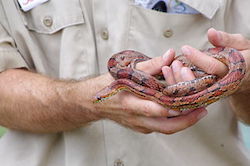
Scientists learn a lot about snakes and other animals through basic research. Image by the Virginia State Park staff.
“Don’t worry, they aren’t dangerous” you hear the zoologist say as she leads you and a group of others toward an area with a number of different snakes. She removes a long snake from a larger glass enclosure and asks who would like to hold it. You take a step back, certain that holding a snake is the last thing you’d like to do.
"But how do you know they aren’t dangerous?” you ask. The zoologist looks up and smiles. She explains that scientists have studied this type of snake, and so we actually know quite a bit about it. This type of snake rarely bites and does not produce venom, so it isn’t dangerous to people. You nod along as she talks about the snakes, their natural habitats, and other details like what they eat.
Animals in the Research Process
How do we know so much about snakes or other animals? Animals are all unique, and scientists study them to learn more about them. For example, by studying snakes we have learned that they stick their tongues out because they are trying to pick up odors around them. This helps them sense food, predators, and other things that may be nearby. When research is performed to expand our understanding of something, like an animal, we call it basic research .
Scientists study animals for other reasons too. What we learn about animals can actually help us find solutions to other problems or to help people. For example, studying snakes helps us understand which ones are venomous so that humans know what kinds of snakes they shouldn't touch. Scientists also study animals to find new treatments to diseases and other ailments that affect both people and animals. If we learn what is in snake venom, we can create a medicine to give to people that have been bitten as a treatment to help them feel better. Using what we know about an animal or thing to help us solve problems or treat disease is called applied research .
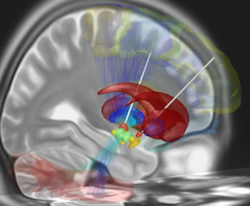
Scientists use many other tools, such as computer models, in addition to animals to study different topics. Image by Andreas Horn.
No matter what type of research is being performed, scientists must consider many things when they study animals.
Do Scientists Need to Study Animals?
Of course we can learn a lot from using animals for research, but are there alternative options? Sometimes there are. For example, scientists could use some other method, like cells or computer models, to study a particular topic instead of using animals. However, for a number of reasons , scientists have found that using animals is sometimes the best way to study certain topics.
What If Scientists Harm Animals for Research?
Some research using animals only requires scientists to watch behavior or to take a few samples (like blood or saliva) from the animal. These activities may cause the animals some stress, but they are unlikely to harm the animals in any long-term way. Studies of the behavior or physiology of an animal in its natural environment is an example of such research.
In other cases, scientists may need to harm or kill an animal in order to answer a research question. For example, a study could involve removing a brain to study it more closely or giving an animal a treatment without knowing what effects it may have. While the intention is never to purposely harm animals, harm can be necessary to answer a research question.
How Do Scientists Decide When It’s OK to Study Animals?

Many animals are used in research. But there is still debate on whether they should be used for this purpose. Image by the United States Department of Agriculture.
There are many guidelines for when it’s ok to use animals in research. Scientists must write a detailed plan of why and how they plan to use animals for a research project. This information is then reviewed by other scientists and members of the public to make sure that the research animals will be used for has an important purpose. Whatever the animals are used for, the scientists also make sure to take care of animal research subjects as best as they can.
Even with rules in place about using animals for research, many people (both scientists and non-scientists) continue to debate whether animals should be used in research. This is an ethical question, or one that depends on a person's morals. Because the way each person feels about both research and animals may be different, there is a range of views on this matter.
- Some people argue that it doesn’t matter that there are rules in place to protect animals. Animals should never be used for research at all, for any reason.
- Others say we should be able to use animals for any kind of research because moving science forward is more important than the rights or well-being of animals.
- Lastly, there are people whose opinions sit somewhere in the middle. They might argue that it’s ok to use animals for research, but only in some cases. For example, if the results of the research are very likely to help treat something that affects people, then it may be okay to use animals.
Along with this debate, there are many advantages and disadvantages of doing animal research . Scientists must weigh these options when performing their research.
Additional Images via Wikimedia Commons. White rat image by Alexandroff Pogrebnoj.
Read more about: Using Animals in Research
View citation, bibliographic details:.
- Article: Using Animals in Research
- Author(s): Patrick McGurrin and Christian Ross
- Publisher: Arizona State University School of Life Sciences Ask A Biologist
- Site name: ASU - Ask A Biologist
- Date published: December 4, 2016
- Date accessed: May 8, 2024
- Link: https://askabiologist.asu.edu/explore/Animal-use-in-Research
Patrick McGurrin and Christian Ross. (2016, December 04). Using Animals in Research. ASU - Ask A Biologist. Retrieved May 8, 2024 from https://askabiologist.asu.edu/explore/Animal-use-in-Research
Chicago Manual of Style
Patrick McGurrin and Christian Ross. "Using Animals in Research". ASU - Ask A Biologist. 04 December, 2016. https://askabiologist.asu.edu/explore/Animal-use-in-Research
MLA 2017 Style
Patrick McGurrin and Christian Ross. "Using Animals in Research". ASU - Ask A Biologist. 04 Dec 2016. ASU - Ask A Biologist, Web. 8 May 2024. https://askabiologist.asu.edu/explore/Animal-use-in-Research

Animals are an important part of research. But many argue about whether it's ethical to use animals to help advance scientific progress.
Using Animals in Research
Be part of ask a biologist.
By volunteering, or simply sending us feedback on the site. Scientists, teachers, writers, illustrators, and translators are all important to the program. If you are interested in helping with the website we have a Volunteers page to get the process started.
Share to Google Classroom

Writing Unit of Study: Animal Research Project
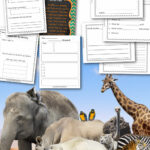
This free animal research project will provide you with a writing unit of study that will help you build excitement about writing informational text in your classroom.
You can download this free animal research project to help your writers develop their research and writing skills.
This project will be a great fit for your first, second or third grade writing workshop.
This is another free resource for teachers and homeschool families from The Curriculum Corner.
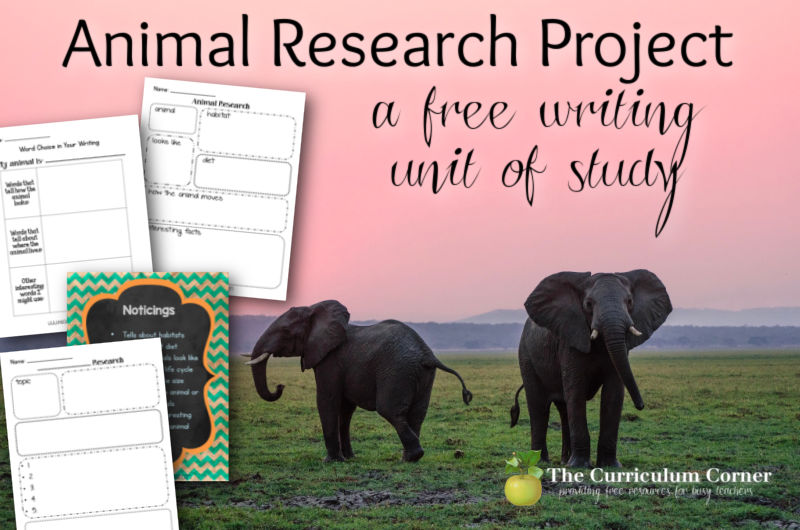
Why should I introduce my students to research through animal study?
Animal research can be a great topic for writing informational text because students tend to be curious about animals.
Nothing seems to spark interest in most kids like learning about animals in our world. Turn their enthusiasm into an engaging animal research writing project.
They can take the time to learn about different habitats and diets.
You can also encourage students to expand their vocabulary by having them create a glossary to accompany their writing.
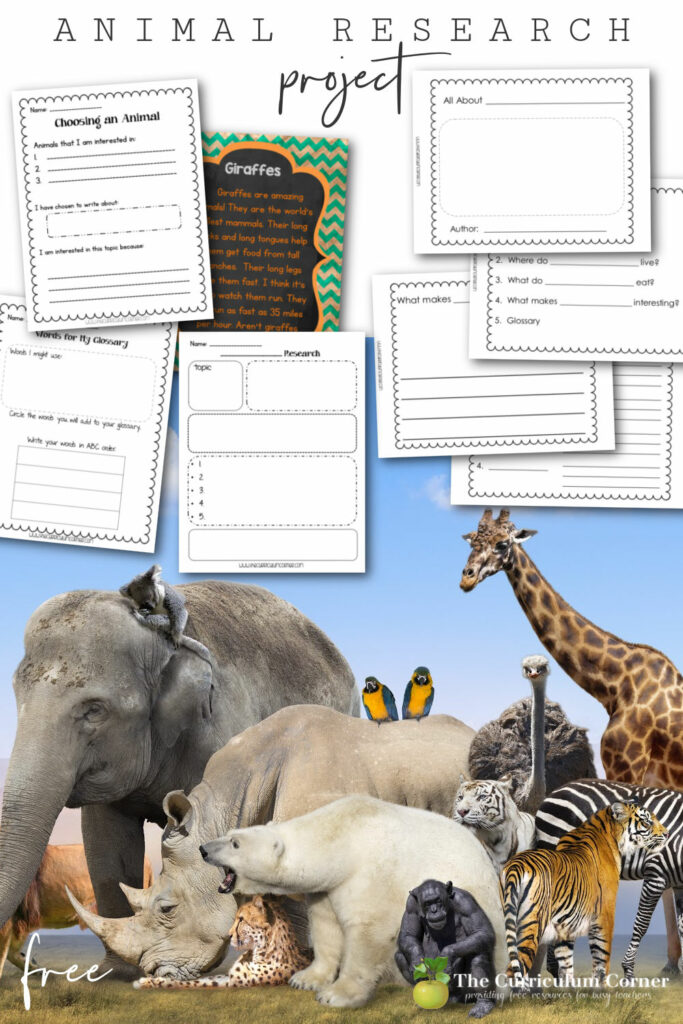
About this animal research project
Within this post you will find over 30 pages of anchor charts, mini-lesson ideas, writing planners and graphic organizers.
The unit will help guide your students through the complete process. In the end, you will be helping to teach your students how to write their own pieces of informational text.
The intended end product for students is an animal booklet that they can staple together to share with others.
Students who are ready for more advanced work, can create a larger project with less direction.
A description of the mini-lessons
Lesson 1: introduction.
- Begin the unit by having the students brainstorm a list of animals that they might see everyday.
- Then, have them brainstorm a list of animals they see when they visit the zoo or walk in the forest. You can do this on the blank anchor chart provided or on cart paper.
- Another option is to place students in groups. They could work to create a list together.
- You might assign each group a continent and have them find animals that live there.
- Pull the class together and have each group share what animals they found that live on their continent.
Lesson 2: Noticings
- Next you might want to get your students familiar with common characteristics about informational texts that teach about animals.
- Have them work in pairs or small groups to go through some books and record their “noticings” about the writing.
- Then come together in a community circle to discuss those noticings and create a class anchor chart.
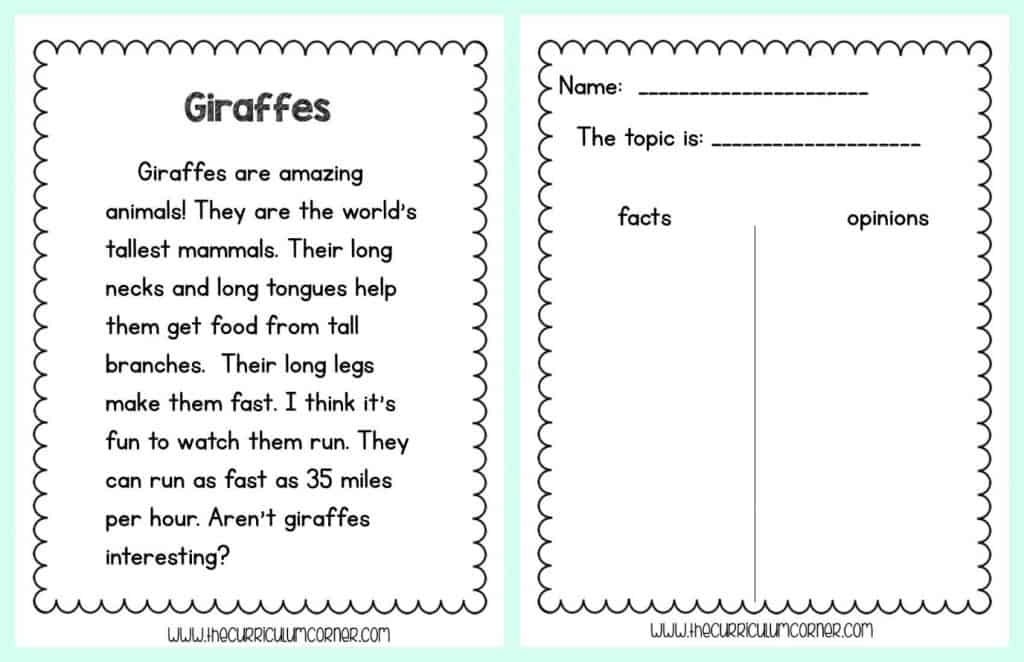
Lesson 3: Opinion vs. Facts
- Before getting truly into this unit, you might need to conduct a lesson on opinions vs. facts.
- After a brief discussion you can use the giraffe paragraph provided in our resources to give your students some practice differentiating between the two. This paragraph contains both opinions and facts.
- With your class read through the paragraph and record facts and opinions on the T-chart.
- Discuss both sides and how they are different from each other.
- A black & white copy of this giraffe paragraph has also been provided. You can have them work in pairs or groups to distinguish between the facts and opinions.
- If you need more resources for your students surrounding fact & opinion check out our Fact & Opinion Sort .
Lesson 4: Choosing a Topic for the Animal Research Project
- We want to help students to narrow their topic choices by giving them some guidance.
- Gather students and begin a discussion about choosing an animal research topic.
- For this lesson we have provided two pages where students can individually brainstorm the animals they are interested in.
- You might have students work in groups or independently to make their choice. Conference with students as needed to help.
- Don’t shy away from letting more than one student research about the same animal. This can be a great way to promote group work. It might also help out with some of your literacy center choices throughout this unit.
Lesson 5: Good Places to Find Information about an Animal
- At this age we want students to begin to understand that all they read online about animals isn’t always true. Sometimes writing might sound true without being filled with facts.
- Show students two possible places to find information online about their animal. One should be a trusted site with reliable and accurate information. Another should be a site that perhaps a child has created. (There are many that you can find if you search.)
- Pose these questions: Is everything on the internet true? Why? How can you tell? Why is it important for your research writing to contain accurate information?

Lesson 6: Taking Notes
- Sometimes giving students resources and a blank sheet of notebook paper can be too overwhelming for them. Some students will copy word for word. Others might feel overwhelmed. We need to guide them to read and pull out facts & relevant information to use later in their writing.
- For this lesson we have provided four templates for note-taking that you might choose to use for your students.
- You might need to provide different organizers to students depending on their needs.
- You will want to model the organizers your students are use. Show them how to take notes as they read.
- After initial teaching, you may find that you need to pull small groups for extra practice. Others might benefit from a conference as you take a look at the notes they are taking.
Lesson 7: Word Choice in Research Writing
- To help students think about making their writing more interesting, have them brainstorm words about their animal.
- Together brainstorm words that would be appropriate for animals. They might add words about what they look like, their movement, their habitats, their life cycles, their diets, etc. You can create a class anchor chart on the page provided. You might even think about using the real life picture of the wolf in the download. This can get the students to begin thinking of more interesting words for animals (fierce, mighty, strong, etc).
- Then, pass out the individual brainstorm pages. Students can use the anchor chart as a guide to begin their own word choice pages about their animal. This might be a good partner activity as well.
Lesson 8: Writing Sketch for the Animal Research Project
- Next, you can model the writing sketch planner for your class.
- One idea to help your students narrow down all of the information they have learned about their animals is to give them a specific number of animals facts that they can focus on.
- Each of these facts can serve as the actual text that they will put on each page of their animal research book. Or the facts could serve as a focus for each paragraph in their writing.
- You might find that this would be a good mini-lesson to do with smaller groups of children.

Lesson 9: Creating a Table of Contents
- Another idea that can be a writing planner AND a page in their animal research book is the table of contents. Pull out one of the Table of Contents pages from the resources provided and model how to fill in the blanks on each page.
- This page will then serve as their Table of Contents (with a focus discussion on what that is and the purpose it serves) and also their writing planner so they know what they will put in the pages of their booklet.
Lesson 10: Creating a Glossary
- There are two pages provided in the resources that might help your students to learn to pull out topic specific words to put into a glossary for the end of their animal research book.
- Be sure to model how you would like for your students to use these organizers (keeping in mind that you may need to copy more than one page if there are more words than the page provides for).
- If your students need a refresher on ABC order check out these links for some added practice/review: ABC Order Task Cards & Fry Word ABC Order Task Cards
Lesson 11: Writing Your Animal Research
- You will decide on the best method for your students to showcase their published animal research.
- You may want your students to use their own creativity in the texts that they write and share. If you’d like a first experience to provide a bit more guidance, we have provided two different sets of pages for booklets.
- One is more guided and the other has less structure and smaller lines for more writing. 15 pages are provided so that you or students can pick what fits their needs.
- This “lesson” may actually become a series of lessons if you choose to model how each page can be used. (We have also included a page with simple writing lines in case students need less guidance than the booklet pages provided.)
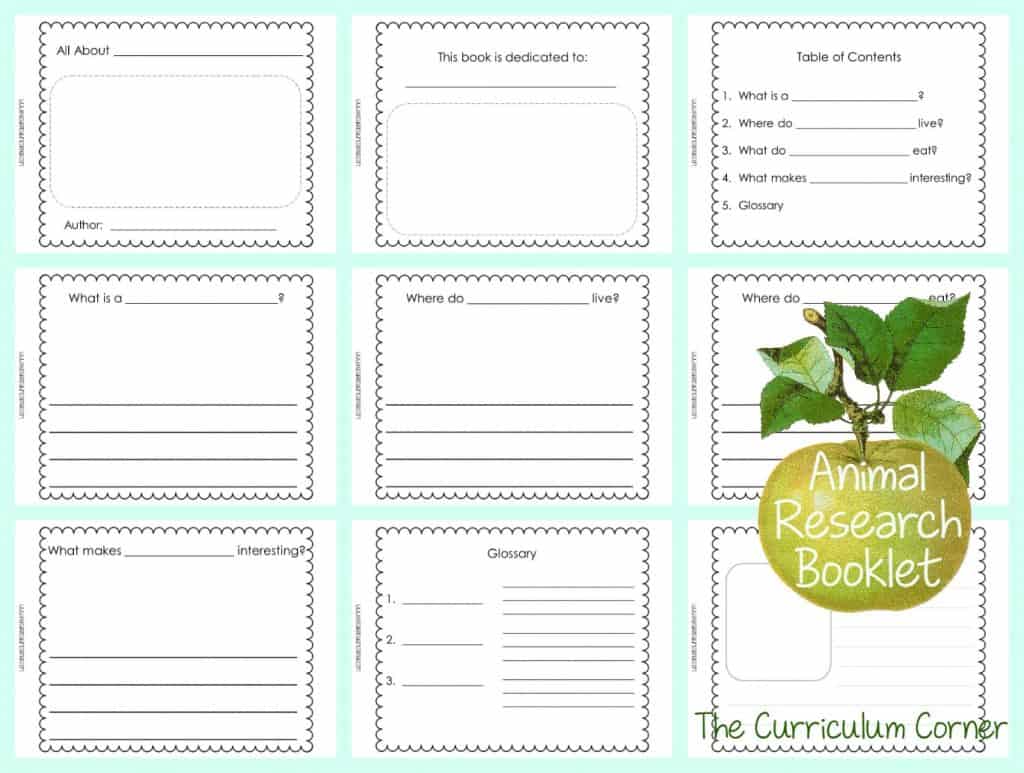
Lesson 12: Labeling Pictures
- One final lesson idea that pairs well with writing informational text is to teach your students how to label pictures.
- Since most nonfiction writing has real photographs, students can find some pictures online to print out and label for their booklet. Hand-drawn pictures are also great if you would rather encourage some or all of your students in that direction.
- Whatever you choose, show your class how to effectively label a picture so that it teaches the reader more. You can use the picture of the polar bear provided to model how to add words or even short facts as labels. (For example if the simple label “fur” wouldn’t add additional information to the book, you might teach them to label it with a short fact such as “dense fur protects the animal’s skin from the weather”.
- To make this idea more user friendly, you might want them to use the page of blank white boxes provided to write their labels for their pictures. Then all they need to do is cut them out and glue them to a printed picture.
Lesson 13: Writing Celebration
As always, find a way to celebrate your students’ writing.
Invite guests (younger students or special adults) to read the books with your young authors. You might simply want to pair or group them, or some students might choose to present their book to everyone.
Provide some light snacks if possible to give it a party atmosphere and pass out the author certificates to each child for his/her hard work.
You can download this free writing unit of study here:
Writing Download
As with all of our resources, The Curriculum Corner creates these for free classroom use. Our products may not be sold. You may print and copy for your personal classroom use. These are also great for home school families!
You may not modify and resell in any form. Please let us know if you have any questions.
Christine E.
Saturday 8th of May 2021
Thank you so much for this resource and the many pages that I can use in my homeschooling. It is exactly what I've been looking for to help me get my kids to write about our animal units! You are doing a great job, keep up the amazing work you do. I appreciate the hard work you put into putting these together.
Planning a Dynamic Writing Workshop - The Curriculum Corner 123
Saturday 14th of July 2018
[…] Animal Research […]
Editable Writing Management Binder - The Curriculum Corner 123
Friday 3rd of March 2017
[…] Writing Unit of Study: Animal Research […]

- About Grants
- Forms & Deadlines
- Grants Policy
- News & Events

Interagency Collaborative Animal Research Education (ICARE) Project

The ICARE Project is a U.S. interagency initiative of the National Institutes of Health (NIH), U.S. Department of Agriculture (USDA), Food and Drug Administration (FDA), National Science Foundation (NSF), U.S. Department of Veterans Affairs (VA), National Aeronautics and Space Administration (NASA), and Biomedical Advanced Research and Development Authority (BARDA). This group of federal agencies is involved in the welfare of animals used in research, teaching, and testing in the US. Although federal animal care and use standards vary, all endorse local oversight for the humane care and use of animals by an IACUC.
The aim of the ICARE Project is to empower U.S. Institutional Animal Care and Use Committees (IACUCs) and their institutions to improve animal welfare and increase compliance with federal standards while minimizing regulatory burden. To accomplish this goal, the ICARE Project uses active learning pedagogy which has been shown to increase the effectiveness of adult education in the factual and theoretical understanding of scientific and ethical issues by engaging the learner in activities that require the application of high-level concepts.
Participants for all ICARE offerings are subject to the OLAW Code of Conduct .
Sign up for OLAW newsletters to be notified of upcoming events!
OLAW Conversations (Virtual)
OLAW Conversations is a discussion-based offering from OLAW, that is part of the ICARE Project, where information is presented by subject matter experts, and attendees add to the conversation by sharing their ideas, perspectives, and questions. Experts will also weigh in on participant discussion to offer insights and ensure regulatory compliance, where applicable. These sessions will not be recorded, and therefore, participation will be limited to those who register for the live events and transcripts will not be available. Participation is open to those involved in animal care and use programs, including IACUC members and staff, Institutional Officials, veterinarians, animal facilities personnel, administrators, consultants, and compliance and regulatory personnel. Registration is free. Please note that OLAW is unable to offer RACE or CPIA credit for these sessions at this time.
The views expressed by speakers and moderators do not necessarily reflect the official policies of the Department of HHS; nor does mention of trade names, commercial practices, or organizations imply endorsement by the U.S. Government.
Resources from Past OLAW Conversations
The following resources have been posted with permission from the speaker.
ICARE Academies (In-Person)
ICARE Academies (IA) offer participants an understanding of research animal welfare and IACUC oversight issues through active learning and scientific teaching. Attendees will work in both large interactive sessions and small facilitated breakout groups. In all of the sessions, attendees will engage in learning activities such as interactive presentations, group work, and discussions. Participation is open to those involved in animal care and use programs, including IACUC members and staff, Institutional Officials, veterinarians, animal facilities personnel, administrators, consultants, and compliance and regulatory personnel. Please note that OLAW is unable to offer RACE or CPIA credit for programs at this time.
ICARE Academies Course Descriptions
IA Intro is a comprehensive 2-day workshop that introduces participants to the regulations and guidelines of the U.S. federal agencies that oversee animal welfare at research institutions. This course is appropriate for those IACUC and animal program personnel who are new to the program, newly promoted, or those who seek a review of federal standards.
IA Refining is a fast-paced 3-day workshop that provides participants with an understanding of animal welfare oversight concepts, enables them to correct misunderstandings of federal standards, and learn methods for more efficient and effective animal program and IACUC functioning. This course is recommended for those IACUC and animal program personnel who are familiar with federal animal welfare oversight standards.
Train the Trainer Institutes (TTI) teach institutional training personnel to use active learning in their training programs. Participants will engage in active learning applied to IACUC subject matter content and modules that address the scientific basis of active learning pedagogy.
Advanced Train the Trainer Institutes (ATTI) offer advanced training in the use of active learning, backward design, and scientific teaching applied to IACUC training. The ATTI is offered to individuals that have completed basic training at TTI.
Training Modules
Training modules developed by the participants of the Train the Trainer Institutes are tools that you can use to implement active learning training for IACUCs at your institution. Additional modules and supplemental materials will be added as they become available.
- ICARE Training Modules
Reference Materials
Thank you for visiting nature.com. You are using a browser version with limited support for CSS. To obtain the best experience, we recommend you use a more up to date browser (or turn off compatibility mode in Internet Explorer). In the meantime, to ensure continued support, we are displaying the site without styles and JavaScript.
- View all journals
- Explore content
- About the journal
- Publish with us
- Sign up for alerts
- Published: 24 September 2021
On the past, present, and future of in vivo science
- Ellen P. Neff 1
Lab Animal volume 50 , pages 273–276 ( 2021 ) Cite this article
265 Accesses
2 Citations
6 Altmetric
Metrics details
Lab Animal asked a group of experts in industry and academia about how the field has changed over their careers and how they think animal research can be improved in the future.
This is a preview of subscription content, access via your institution
Access options
Subscribe to this journal
We are sorry, but there is no personal subscription option available for your country.
Buy this article
- Purchase on Springer Link
- Instant access to full article PDF
Prices may be subject to local taxes which are calculated during checkout
Garner, J. P. et al. Lab. Anim. (NY) 46 , 103–113 (2017).
Article Google Scholar
Voelkl, B. et al. Nat. Rev. Neurosc. 21 , 384–393 (2020).
Article CAS Google Scholar
Kafkafi, N. et al. Neurosci. Biobehav. Rev. 87 , 218–232 (2018).
Agassi, J. Francis Bacon, Robert Boyle (eds), Boston Studies in the Philosophy and History of Science 298 (Springer Science + Business Media, Dordrecht, 2013).
Macleod, M. R. et al. PLoS Biol. 13 , e1002273 (2015).
Nuzzo, R. Nature 506 , 150–152 (2014).
Kilkenny, C. et al. PLoS ONE 4 , e7824 (2009).
van der Worp, H. B. et al. PLoS Med. 7 , e1000245 (2010).
Kilkenny, C. et al. PLoS Biol. 8 , e1000412 (2010).
Percie du Sert, N. et al. PLOS Biol. 18 , e3000410 (2020).
Percie du Sert, N. et al. PLOS Biol. 18 , e3000411 (2020).
Karp, N. A. & Fry, D. BMJ Open Sci. 5 , e100126 (2021).
Smith, A. J. Lab. Anim. Res. 36 , 21 (2020).
Bertelsen, T. & Øvlisen, K. Lab. Anim. https://doi.org/10.1177/00236772211014433 (2021).
Garner, J. P. ILAR J. 55 , 438–56 (2014).
Genzel, L. et al. Curr. Biol. 30 , R1014–R1018 (2020).
Eggel, M. & Wurbel, H. Lab. Anim. 55 , 233–24 (2021).
Voelkl, B. et al. PLoS Biol. 16 , e2003693 (2018).
Karp, N. A. et al. Sci. Rep. 10 , 6178 (2020).
Download references
Author information
Authors and affiliations.
Lab Animal http://www.nature.com/laban/
Ellen P. Neff
You can also search for this author in PubMed Google Scholar
Corresponding author
Correspondence to Ellen P. Neff .
Rights and permissions
Reprints and permissions
About this article
Cite this article.
Neff, E.P. On the past, present, and future of in vivo science. Lab Anim 50 , 273–276 (2021). https://doi.org/10.1038/s41684-021-00848-2
Download citation
Published : 24 September 2021
Issue Date : October 2021
DOI : https://doi.org/10.1038/s41684-021-00848-2
Share this article
Anyone you share the following link with will be able to read this content:
Sorry, a shareable link is not currently available for this article.
Provided by the Springer Nature SharedIt content-sharing initiative
This article is cited by
Turning fifty.
Lab Animal (2021)
Quick links
- Explore articles by subject
- Guide to authors
- Editorial policies
Sign up for the Nature Briefing newsletter — what matters in science, free to your inbox daily.

How to Explode Student Engagement with this Habitat Research Project

One HUGE 2nd grade standard is researching and learning about animals and their adaptations. Students LOVE this unit, but teachers can be intimidated by the overwhelming pressure involved in guiding student research at such a young age. I love doing this 2nd grade animal research project with my students every March! This project has been reworked for a digital platform as well .

I love to start by playing a Brain Pop Jr, Flocabulary or YouTube video for my kids on all of the different habitats that exist. Typically, we have previously researched habitats during our social studies unit before starting this writing project, so they already have the background knowledge.
Then, I let students pick the habitat they are most interested in studying. From there, they pick 3-4 animals that live in the habitat that they would like to research more about. We use National Geographic Kids , Epic! Books and library books [all free resources] to learn about our animals.
2. RESEARCH/PLANNING

The next day, I model my own notes for students. Then, I give students lots of time to research their animals and take notes. It is really important that you are walking around the room and guiding students during this time.
If you have a struggling group of writers, I like to work with them at the back table during this time. We all research the same animals and take notes together. This helps them build confidence and feel sure about their writing in future days.
3. DRAFTING
I break drafting days up into 2 days so that students can really focus on the craft of what they are writing. I also always model before releasing students to write on their own.

Depending on what we have covered so far in the year, I encourage students to be sure to add:
- embedded definitions
- transition words
- conjunctions
- adjectives, adverbs and prepositions where appropriate
- 3-4 details per fact
4. PUBLISHING/GRADING

On the last day for each animal (typically Friday), I give students time to publish. While they publish, I model then ask them to add a map and diagram to their writing. I also show them how to grade themselves on the rubric, so they can double check that they are not missing anything.
After they finish, I give them free time to explore other animals in their habitat while I grade their writing. I find grading at the end of each animal rather than at the end of the entire project saves me a TON of time.
We repeat steps 2-4 for either 3 or 4 animals. Some students may work faster, while some may take a bit more time on each step. I try to adjust the project to be appropriate for the majority of the class.

When the project is done, I try to find a special way for us to share our work. This can include sharing to younger buddies, parents or doing an author’s chair.
Since they work so hard on this project, we make a BIG DEAL out of the finished project, and I typically send it home with parents during conferences. It makes a great writing portfolio and talking piece with parents.

Teaching digitally or wanting to add a digital component to your writing block? This project can also be completed in a digital format . Students will go through the same process, completing all of their work on Google Slides rather than writing using paper and pencil.
Grab the resources pictured above here:

Do you teach about a 2nd grade animal research project each year? Drop your ideas in the comments below!
Some other posts you might find helpful are:
- Teaching Animal Habitats During Science Ideas
- Animal Adaptations Writing Project
- Life Science Unit: Animal Adaptation
Emily - The Mountain Teacher
Share your thoughts... cancel reply.
Your email address will not be published. Required fields are marked *
DON'T MISS THE LATEST FREEBIES, RESOURCES, IDEAS & MORE!
Quick links.
- The Mountain Teacher 2024
- Site Design by Laine Sutherland Designs
Library Management
Lesson Plans
Reading Motivation

Library Skills
Reading & Literacy

5 Animal Research Websites for Students
- stayingcoolinthelibrary
- February 24, 2019
- Lesson Plans , Research

Ready to do some animal research? Finding trustworthy and appropriate animal websites for students to use can be a challenge. Below are my go-to websites that you can feel confident having your students go to. Most of these sites also have videos, games and other educational activities as well.
National Geographic for Kids
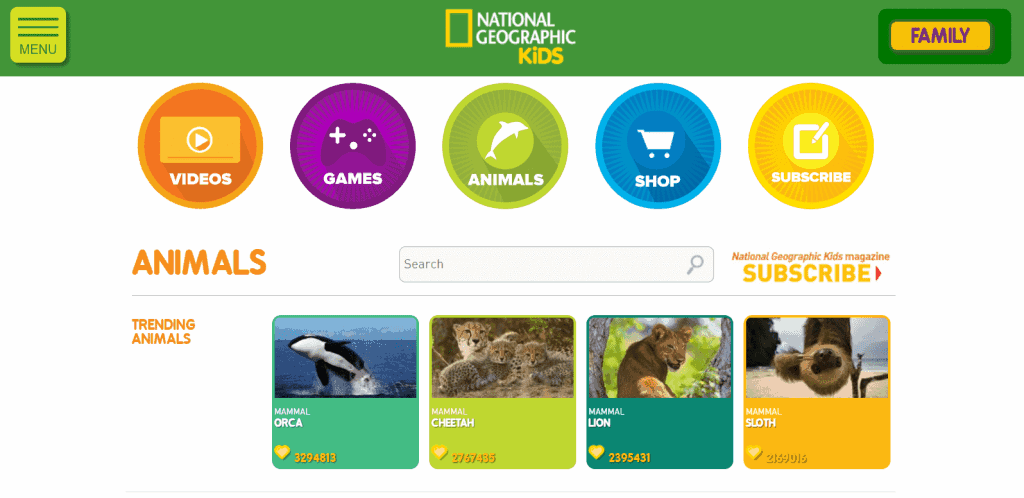
DK Find Out
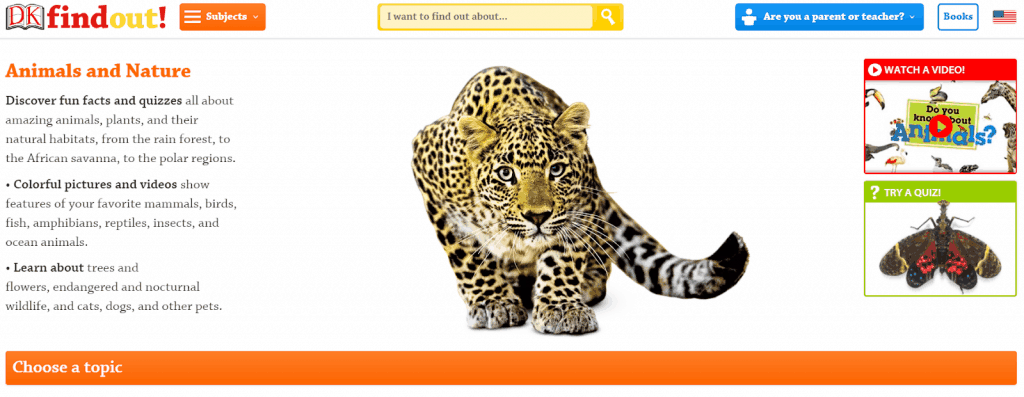
San Diego Zoo Kids
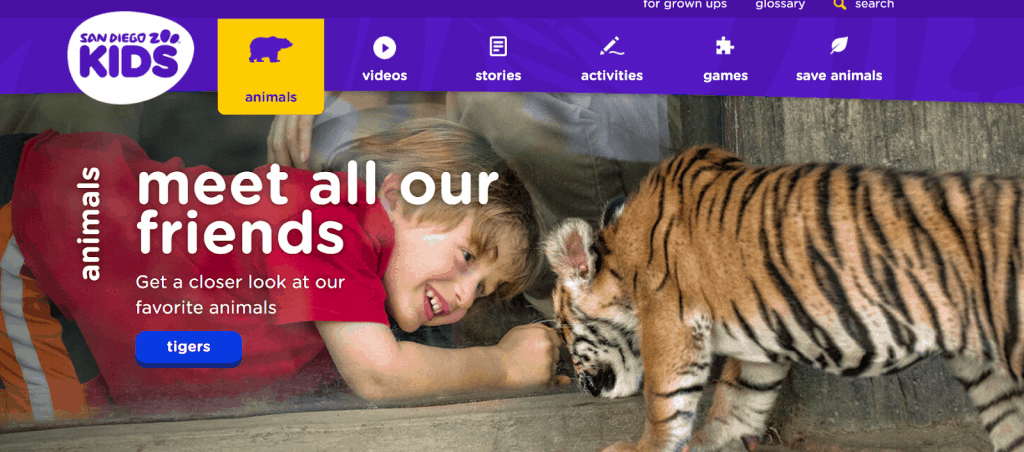
These websites below do have some advertisements on them.

Animal Fact Guide
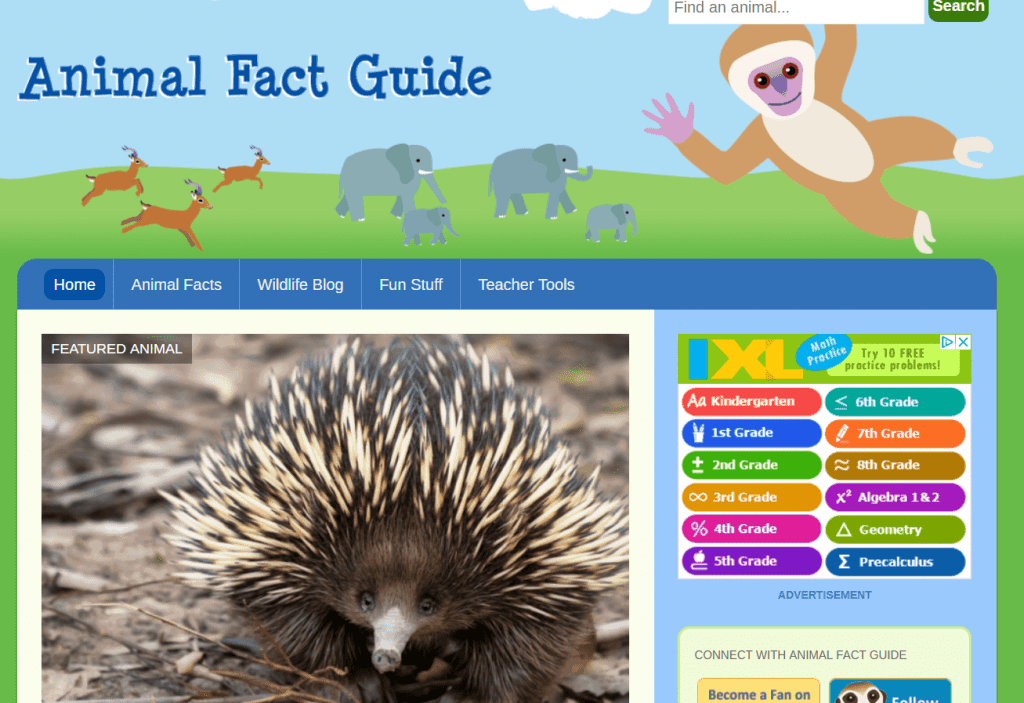
Ready to research and use these animal websites for students?

Thank you for subscribing! A confirmation message has been sent to you with a link you MUST click on in order to begin receiving emails and gain access to the free resource library. Open your inbox and look for a message from " [email protected] ".
There was an error submitting your subscription. Please try again.
QUICK LINKS
RESOURCE LIBRARY
BESTSELLING PRODUCTS
DIGITAL LITERACY SKILLS
RESEARCH SKILLS
NOPREP PRINTABLES
PICTURE BOOK ACTIVITIES
LEGAL STUFF
DISCLOSURE POLICY
PRIVACY POLICY
TERMS AND CONDITIONS
© 2024 STAYING COOL IN THE LIBRARY | All Rights Reserved
Privacy Overview

Animal behavior research is getting better at keeping observer bias from sneaking in – but there’s still room to improve
Professor and Associate Head of Psychology, University of Tennessee
Disclosure statement
Todd M. Freeberg does not work for, consult, own shares in or receive funding from any company or organisation that would benefit from this article, and has disclosed no relevant affiliations beyond their academic appointment.
University of Tennessee provides funding as a member of The Conversation US.
View all partners
Animal behavior research relies on careful observation of animals. Researchers might spend months in a jungle habitat watching tropical birds mate and raise their young. They might track the rates of physical contact in cattle herds of different densities. Or they could record the sounds whales make as they migrate through the ocean.
Animal behavior research can provide fundamental insights into the natural processes that affect ecosystems around the globe, as well as into our own human minds and behavior.
I study animal behavior – and also the research reported by scientists in my field. One of the challenges of this kind of science is making sure our own assumptions don’t influence what we think we see in animal subjects. Like all people, how scientists see the world is shaped by biases and expectations, which can affect how data is recorded and reported. For instance, scientists who live in a society with strict gender roles for women and men might interpret things they see animals doing as reflecting those same divisions .
The scientific process corrects for such mistakes over time, but scientists have quicker methods at their disposal to minimize potential observer bias. Animal behavior scientists haven’t always used these methods – but that’s changing. A new study confirms that, over the past decade, studies increasingly adhere to the rigorous best practices that can minimize potential biases in animal behavior research.

Biases and self-fulfilling prophecies
A German horse named Clever Hans is widely known in the history of animal behavior as a classic example of unconscious bias leading to a false result.
Around the turn of the 20th century , Clever Hans was purported to be able to do math. For example, in response to his owner’s prompt “3 + 5,” Clever Hans would tap his hoof eight times. His owner would then reward him with his favorite vegetables. Initial observers reported that the horse’s abilities were legitimate and that his owner was not being deceptive.
However, careful analysis by a young scientist named Oskar Pfungst revealed that if the horse could not see his owner, he couldn’t answer correctly. So while Clever Hans was not good at math, he was incredibly good at observing his owner’s subtle and unconscious cues that gave the math answers away.
In the 1960s, researchers asked human study participants to code the learning ability of rats. Participants were told their rats had been artificially selected over many generations to be either “bright” or “dull” learners. Over several weeks, the participants ran their rats through eight different learning experiments.
In seven out of the eight experiments , the human participants ranked the “bright” rats as being better learners than the “dull” rats when, in reality, the researchers had randomly picked rats from their breeding colony. Bias led the human participants to see what they thought they should see.
Eliminating bias
Given the clear potential for human biases to skew scientific results, textbooks on animal behavior research methods from the 1980s onward have implored researchers to verify their work using at least one of two commonsense methods.
One is making sure the researcher observing the behavior does not know if the subject comes from one study group or the other. For example, a researcher would measure a cricket’s behavior without knowing if it came from the experimental or control group.
The other best practice is utilizing a second researcher, who has fresh eyes and no knowledge of the data, to observe the behavior and code the data. For example, while analyzing a video file, I count chickadees taking seeds from a feeder 15 times. Later, a second independent observer counts the same number.
Yet these methods to minimize possible biases are often not employed by researchers in animal behavior, perhaps because these best practices take more time and effort.
In 2012, my colleagues and I reviewed nearly 1,000 articles published in five leading animal behavior journals between 1970 and 2010 to see how many reported these methods to minimize potential bias. Less than 10% did so. By contrast, the journal Infancy, which focuses on human infant behavior, was far more rigorous: Over 80% of its articles reported using methods to avoid bias.
It’s a problem not just confined to my field. A 2015 review of published articles in the life sciences found that blind protocols are uncommon . It also found that studies using blind methods detected smaller differences between the key groups being observed compared to studies that didn’t use blind methods, suggesting potential biases led to more notable results.
In the years after we published our article, it was cited regularly and we wondered if there had been any improvement in the field. So, we recently reviewed 40 articles from each of the same five journals for the year 2020.
We found the rate of papers that reported controlling for bias improved in all five journals , from under 10% in our 2012 article to just over 50% in our new review. These rates of reporting still lag behind the journal Infancy, however, which was 95% in 2020.
All in all, things are looking up, but the animal behavior field can still do better. Practically, with increasingly more portable and affordable audio and video recording technology, it’s getting easier to carry out methods that minimize potential biases. The more the field of animal behavior sticks with these best practices, the stronger the foundation of knowledge and public trust in this science will become.
- Animal behavior
- Research methods
- Research bias
- STEEHM new research

Events and Communications Coordinator

Assistant Editor - 1 year cadetship

Executive Dean, Faculty of Health

Lecturer/Senior Lecturer, Earth System Science (School of Science)

Sydney Horizon Educators (Identified)

How Some Animals Can Survive—and Even Thrive—After Being Exposed to Nuclear Radiation
Nearly 40 years of research into the contaminated area around Chernobyl is providing some clues.
When analyzing DNA from roughly 300 dogs, scientists discovered remarkable genetic differences in those living in the plant compared to those living 10 miles away in uncontaminated areas. The results hint at the long-term consequences of radiation on biology, showing that increased radiation could have impacted their physiology, evolution , and more.
“There is the possibility that we might find some aspect of their physiology that could provide other organisms protection,” Tim Mousseau, the study’s author and researcher at the University of South Carolina, tells Popular Mechanics .
The scientists can’t tell us exactly how the dogs and their descendants managed to resist radiation , but researching them offers a tantalizing opportunity to study how living things survive in its presence. Are they merely getting by? Or have they evolved a biological strategy of resistance?
For the dogs, we will have to wait a bit longer to find out. In the meantime, though, we can look to research on other animals. Scientists have been looking to man-made nuclear disasters like Chernobyl and Fukushima, Japan , for decades to understand radiation’s effects on a menagerie of organisms that include simple life forms like bacteria and fungi, and also frogs, birds, and small mammals.
They want to know how living things can survive in such harsh environments. Or, even, if they could thrive. The answers to these questions hold enticing solutions for humankind in various ways, like advancing cancer therapy, achieving a route to safe space travel , or even developing protective strategies against future nuclear disasters .
Radiation’s Invisible Effects
To understand how animals might resist radiation at Chernobyl, it is first necessary to establish how radiation harms living things.
Radiation is everywhere on the planet. We catch it from the sun’s rays, rocks underground, and even fruits and vegetables. Most of this radiation is harmless, like microwaves and visible light. It is called non-ionizing radiation.
But nuclear radiation is in another category called ionizing radiation. It exists as high-speed charged particles or electromagnetic waves. It damages cells by its ability to ionize atoms and works in two primary ways . First, it ionizes atoms in molecular building blocks of cells; it can knock off the electrons and break the molecular bonds in DNA and other cell parts. Second, it can ionize water molecules, creating highly reactive free radicals in the body that also disrupt DNA’s molecular bonds.
High doses of radiation delivered over a short time period, like those endured by victims and clean-up workers at Chernobyl, cause acute radiation sickness and death within days. Studies of the atomic bomb victims in Hiroshima and Nagasaki detailed hundreds of thousands of casualties and a range of illnesses , including cataracts, cancer, neurodevelopmental disorders, and more.
After the initial blast at Chernobyl, which delivered 400 times more radiation than the atomic bomb dropped on Hiroshima, plants and wildlife were devastated. In the area around the nuclear plant, the radioactive cloud killed a pine forest within months, turning the trees an eerie red color and earning it the name “the red forest.”
In the years following the accident, radiation levels slowly decreased as the radioactive particles decayed. Rumors circulated that animals had moved back into the abandoned area and thrived in the absence of humans. Scientists began considering whether the human effect on wildlife has been worse than radiation.
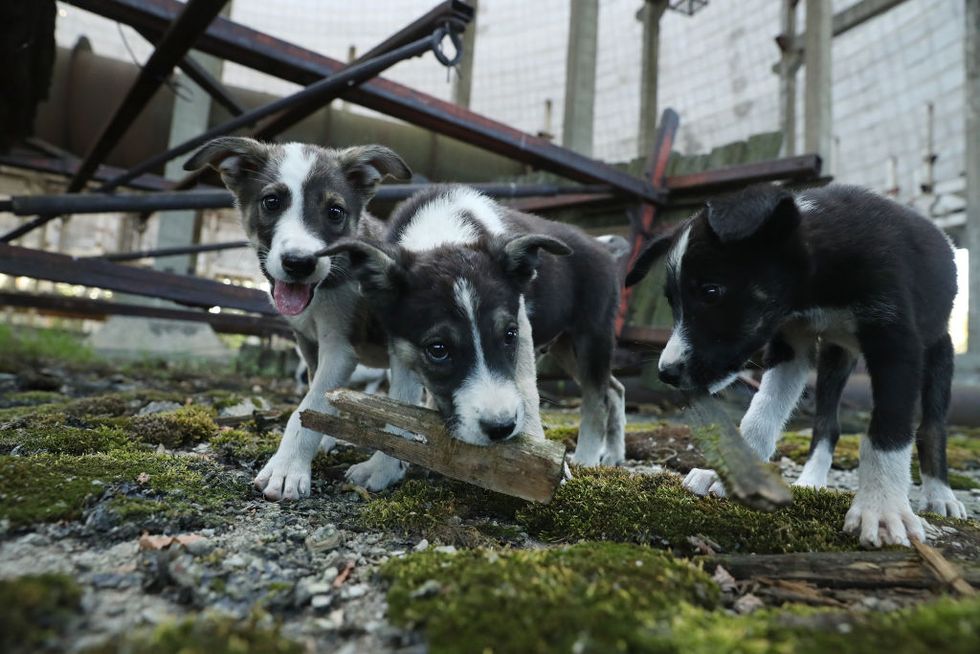
But this, of course, was controversial. Mousseau wants you to know that radiation is overwhelmingly harmful to living things. He and his long-time colleague, Anders Møller, have presented many research papers showing a grim picture, with species in the fallout zone having more genetic mutations and smaller brains . They’ve documented a loss of biodiversity in insects , birds , and soil invertebrates .
Polina Volkova, an independent researcher who studies radiation’s effects on plants, paints a different picture. She tells Popular Mechanics that she has seen many large mammals in the Chernobyl Exclusion Zone with her own eyes, including elk, deer, wolves, and bison. “Regarding radioresistance, we can expect that long-living organisms will develop strategies to mitigate the effect of chronic irradiation,” she says.
Other research papers have contradicted the work of Mousseau and Møller, showing no reduction in biodiversity in the area. There are published studies demonstrating a rich diversity of plants and animals have recolonized the red forest like a wilderness preserve. What both sides seem to agree on is that there is a wide range of responses to radiation, and living things have a great deal of variation in their responses. “There is tremendous variation in tolerance to radiation in different critters and different cell lines,” says Mousseau.
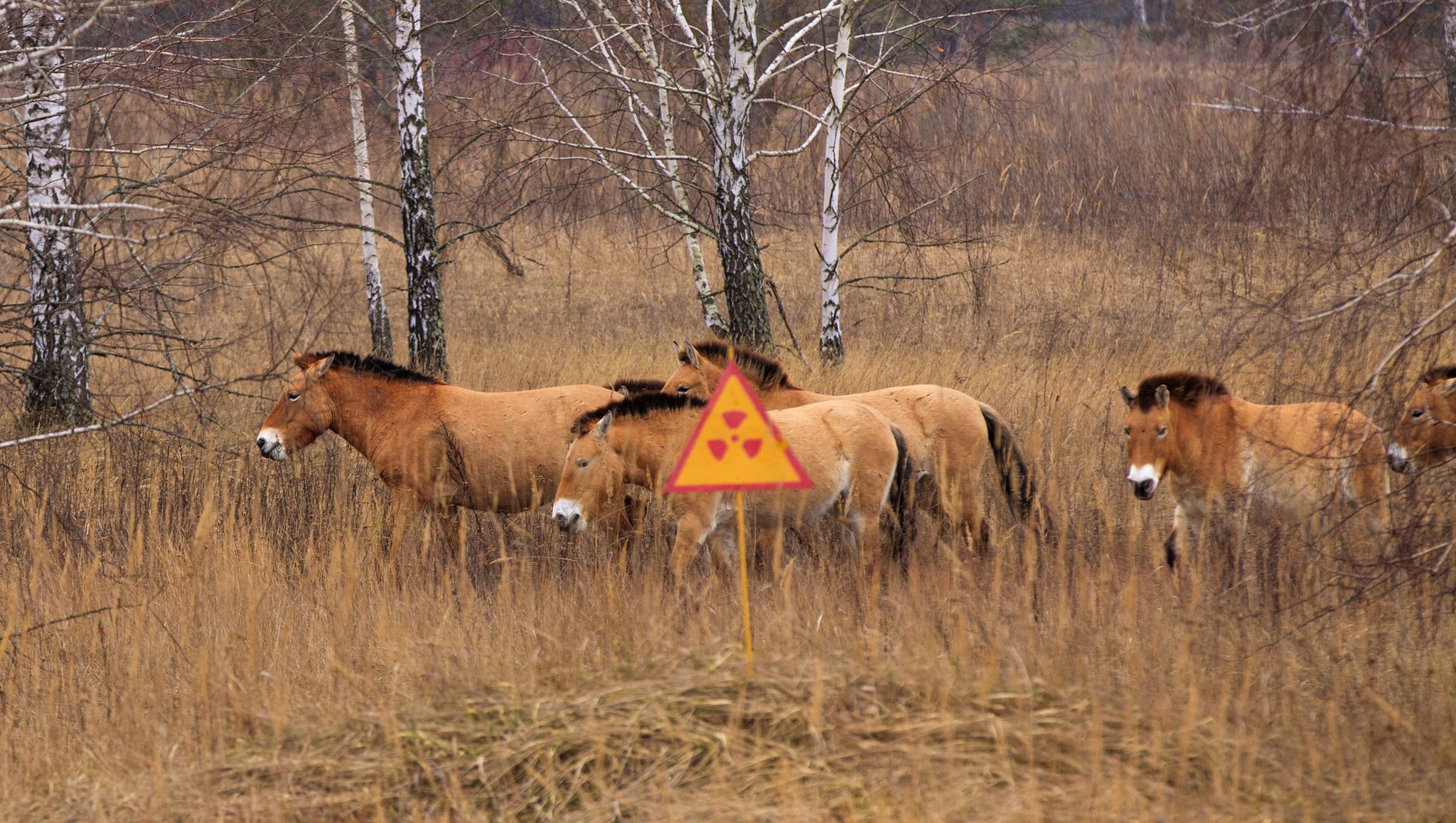
What Animals Can Survive Radiation?
The best-known examples of radiation-resistant organisms are bacteria and fungi. Michael Cox, a molecular biologist at the University of Wisconsin, tells Popular Mechanics that bacteria that evolved to live in harsh desert climates have developed multiple mechanisms for repairing the DNA damage that comes from radiation.
Scientists first demonstrated their resilience in experiments done nearly two decades ago. They took a thimbleful of soil from the Sonoran Desert and one from a marsh in Louisiana. Later, they exposed both samples to high doses of ionizing radiation, and the soil bacteria from the Sonoran Desert survived.
Cox explains that desert bacteria have evolved to go into a dormant state in the extremely harsh and dry desert locations. During this dormancy they acquire DNA damage, but when it rains, the bacteria need to spring to life, repair the DNA damage quickly, and reproduce while they can. The rush to repair and reproduce has endowed them with extra radiation-resistant capabilities.
“It’s one of the things that has made me confident that if we do something stupid and blow ourselves up, we are not going to wipe out all life on the planet,” says Cox. “There are some living things that will survive.”
There are also some fungi that not only survive in radioactive environments but even appear to use radiation as an energy source in a process known as radiosynthesis. These fungi contain melanin, which seems to have a protective effect against radiation damage. Even plants have shown some adaptation. Birch pollen and evening primrose seeds collected from the contaminated areas around Chernobyl have shown improved DNA repair systems since the accident.
As far as more complex animals go, there is much less known, and it is what Mousseau is trying to understand with his study on dogs. Although he remains skeptical that animals can evolve to thrive in high-radiation environments, he admits some may adapt to tolerate it.

“We have reasons to believe it is very difficult to evolve resistance, but at the same time, one of the most profound observations of all our work is the tremendous variation among individuals and among species and their sensitivity to radioactivity,” he says.
Mousseau says that in studies of birds and small mammals, they found species with increased antioxidants, which neutralize the oxidative damage caused by free radicals and radiation. One example of this protective mechanism is in a small rodent called a bank vole, which is prevalent throughout the Chernobyl region.
In research published in 2018 , scientists studied the cells of bank voles that inhabit the Chernobyl nuclear power plant, where background radiation levels are 100 times greater than in uncontaminated areas. The scientists took samples of skin cells from the Chernobyl bank voles and from those living in an uncontaminated area. They exposed the cell samples to a 10 Gy dose of gamma radiation. Typically, 4 to 5 Gy of gamma radiation over a short period of time is lethal to humans.
The researchers found the skin cells from the Chernobyl bank voles were able to sustain higher doses and had, on average, higher antioxidant levels. They later tested the cells against three DNA-damaging drugs and found that the Chernobyl cells were more resistant. “They had almost twice the total antioxidant capacity than the control cells,” Mousseau says.
But in order for scientists to truly understand the effects of radiation, they will have to keep probing the animals and plants in the region, looking for the secrets in their DNA that allow them to survive. And so Mousseau and others will continue to travel to the abandoned wasteland looking for clues into how life there persists.
Monique Brouillette is a freelance contributor who writes about biology.

.css-cuqpxl:before{padding-right:0.3125rem;content:'//';display:inline;} Pop Mech Pro .css-xtujxj:before{padding-left:0.3125rem;content:'//';display:inline;}

Ukraine Is Using an Ancient Weapon on Russia

Inside the CIA’s Quest to Steal a Soviet Sub

Jumpstart Your Car With a Cordless Tool Battery

Lost Villa of Rome’s Augustus Potentially Found

Could Freezing Your Brain Help You Live Forever?

Air Force’s Combat Drone Saga Has Taken a Turn

China’s Building a Stealth Bomber. U.S. Says ‘Meh’

A Supersonic Bomber's Mission Ended in Flames

Who Wants to Buy the A-10 Warthog?

US Army Accepts Delivery of First M10 Assault Gun

Underwater UFO is a Threat, Says Ex-Navy Officer
- Election 2024
- Entertainment
- Newsletters
- Photography
- Personal Finance
- AP Investigations
- AP Buyline Personal Finance
- AP Buyline Shopping
- Press Releases
- Israel-Hamas War
- Russia-Ukraine War
- Global elections
- Asia Pacific
- Latin America
- Middle East
- Election Results
- Delegate Tracker
- AP & Elections
- Auto Racing
- 2024 Paris Olympic Games
- Movie reviews
- Book reviews
- Personal finance
- Financial Markets
- Business Highlights
- Financial wellness
- Artificial Intelligence
- Social Media
A wild orangutan used a medicinal plant to treat a wound, scientists say
Scientists say they’ve observed an orangutan named Rakus appearing to treat a wound with medicine from a tropical plant. It’s the latest example of how some animals attempt to soothe their own ills with remedies found in the wild.
This combination of photos provided by the Suaq foundation shows a facial wound on Rakus, a wild male Sumatran orangutan in Gunung Leuser National Park, Indonesia, on June 23, 2022, two days before he applied chewed leaves from a medicinal plant, left, and on Aug. 25, 2022, after his facial wound was barely visible. (Armas, Safruddin/Suaq foundation via AP)
- Copy Link copied
This photo provided by the Suaq foundation shows Rakus, a wild male Sumatran orangutan in Gunung Leuser National Park, Indonesia, on Aug. 25, 2022, after his facial wound was barely visible. Two months earlier, researchers observed him apply chewed leaves from a plant, used throughout Southeast Asia to treat pain and inflammation and to kill bacteria, to the wound. (Safruddin/Suaq foundation via AP)
This photo provided by the Suaq foundation shows a facial wound on Rakus, a wild male Sumatran orangutan in Gunung Leuser National Park, Indonesia, on June 23, 2022, two days before he applied chewed leaves from a plant, used throughout Southeast Asia to treat pain and inflammation and to kill bacteria, to the wound. (Armas/Suaq foundation via AP)
WASHINGTON (AP) — An orangutan appeared to treat a wound with medicine from a tropical plant— the latest example of how some animals attempt to soothe their own ills with remedies found in the wild, scientists reported Thursday.
Scientists observed Rakus pluck and chew up leaves of a medicinal plant used by people throughout Southeast Asia to treat pain and inflammation. The adult male orangutan then used his fingers to apply the plant juices to an injury on the right cheek. Afterward, he pressed the chewed plant to cover the open wound like a makeshift bandage, according to a new study in Scientific Reports .
Previous research has documented several species of great apes foraging for medicines in forests to heal themselves, but scientists hadn’t yet seen an animal treat itself in this way.
“This is the first time that we have observed a wild animal applying a quite potent medicinal plant directly to a wound,” said co-author Isabelle Laumer, a biologist at the Max Planck Institute of Animal Behavior in Konstanz, Germany.
The orangutan’s intriguing behavior was recorded in 2022 by Ulil Azhari, a co-author and field researcher at the Suaq Project in Medan, Indonesia. Photographs show the animal’s wound closed within a month without any problems.
Scientists have been observing orangutans in Indonesia’s Gunung Leuser National Park since 1994, but they hadn’t previously seen this behavior.
“It’s a single observation,” said Emory University biologist Jacobus de Roode, who was not involved in the study. “But often we learn about new behaviors by starting with a single observation.”
“Very likely it’s self-medication,” said de Roode, adding that the orangutan applied the plant only to the wound and no other body part.
It’s possible Rakus learned the technique from other orangutans living outside the park and away from scientists’ daily scrutiny, said co-author Caroline Schuppli at Max Planck.
Rakus was born and lived as a juvenile outside the study area. Researchers believe the orangutan got hurt in a fight with another animal. It’s not known whether Rakus earlier treated other injuries.
Scientists have previously recorded other primates using plants to treat themselves.
Bornean orangutans rubbed themselves with juices from a medicinal plant, possibly to reduce body pains or chase away parasites.
Chimpanzees in multiple locations have been observed chewing on the shoots of bitter-tasting plants to soothe their stomachs. Gorillas, chimpanzees and bonobos swallow certain rough leaves whole to get rid of stomach parasites.
“If this behavior exists in some of our closest living relatives, what could that tell us about how medicine first evolved?” said Tara Stoinski, president and chief scientific officer of the nonprofit Dian Fossey Gorilla Fund, who had no role in the study.
The Associated Press Health and Science Department receives support from the Howard Hughes Medical Institute’s Science and Educational Media Group. The AP is solely responsible for all content.
Deadly brain disease found in two California deer
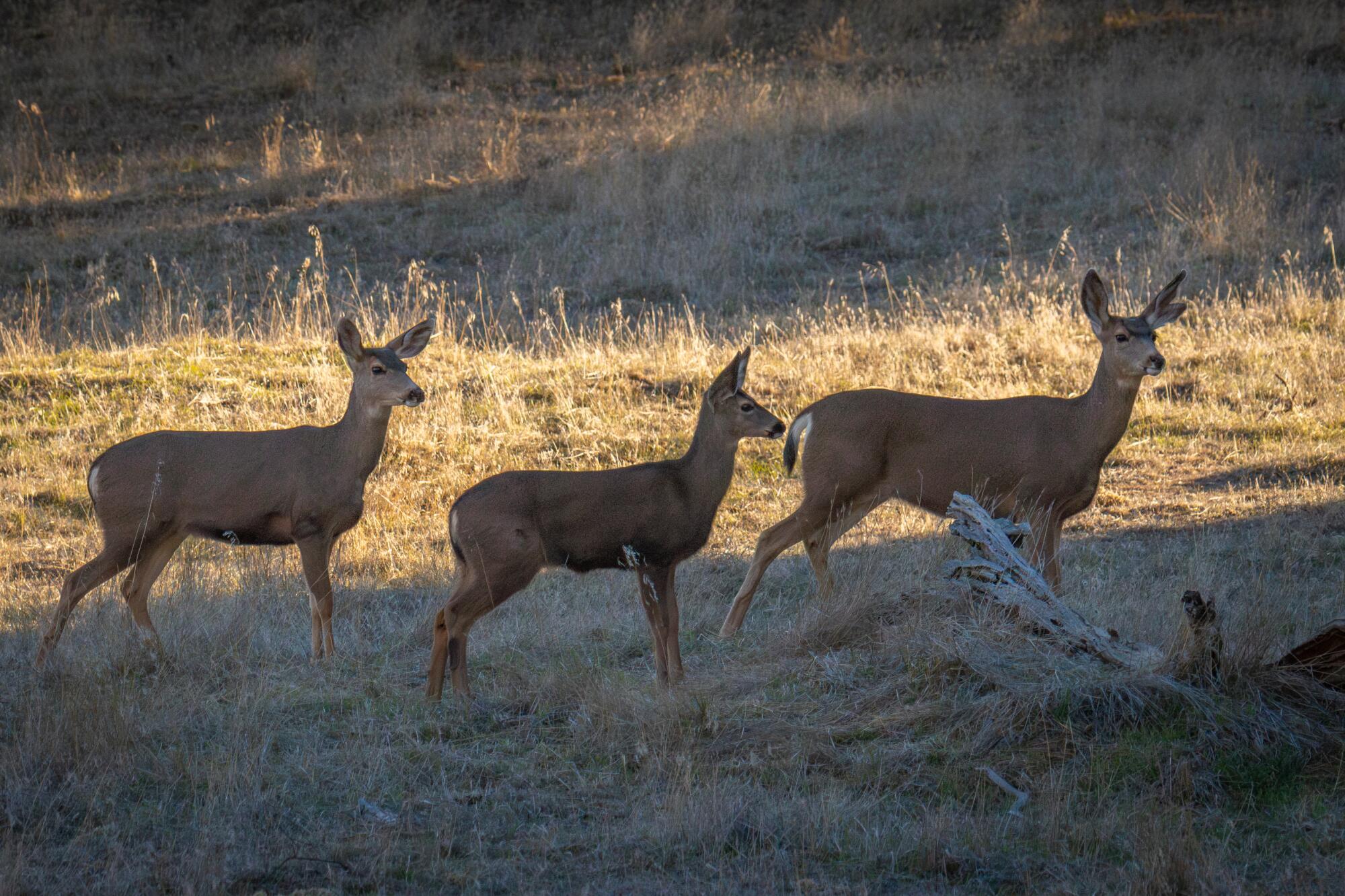
- Show more sharing options
- Copy Link URL Copied!
State officials reported the presence of deadly chronic wasting disease in two wild California deer earlier this week. This is the first time the disease, which has plagued other areas of the nation for years, has appeared in the state’s deer or elk population.
The positive samples came from a deer that died of unknown causes near Yosemite Lakes in Madera Counry, and another killed by a vehicle strike near Bishop in Inyo County.
“The disparate locations of these two detections indicate that CWD has probably been present in California for some time, since the incubation period can be months to years,” state wildlife officials said in an announcement Tuesday.

Climate & Environment
What are the blue blobs washing up on SoCal beaches? Welcome to Velella velella Valhalla
What are those blue things washing up on Southern California beaches? Velella velella, of course. Also known as by-the-wind sailors. They’re kind of like jellyfish.
May 3, 2024
According to experts, the disease can take a year or more to develop in an animal once it is exposed. The disease is fatal and there are no known treatments or vaccines.
Also known as “zombie deer disease,” chronic wasting disease is a contagious infection similar to mad cow disease, or bovine spongiform encephalopathy.
The disease has been detected in animals in North America — including Canada and 34 states in the U.S. — as well as Norway and South Korea.
The disease attacks the brain and nervous system, and targets members of the cervid family, such as deer, elk, reindeer and moose. According to the U.S. Centers for Disease Control and Prevention, symptoms of infected animals include include drastic weight loss (wasting), stumbling, listlessness and other neurologic symptoms.

Science & Medicine
Canny as a crocodile but dumber than a baboon — new research ponders T. rex’s brain power
T. rex intelligence was likely much closer to that of modern-day crocodiles than primates — a perfectly respectable amount of smarts for a therapod.
April 29, 2024
There is no indication that it affects humans. However, health officials said it is critical to keep the disease out of the food supply.
The state’s department of fish and wildlife has been monitoring California elk and deer populations for zombie deer disease since 2000. Officials have been working to increase surveillance efforts, and ask hunters to have their quarry tested at one of several sampling stations.
“The public can help limit the spread of CWD by reporting any signs of illness in deer and elk populations, and hunters should strongly consider testing their harvested deer or elk.,” said Brandon Munk, the state’s wildlife veterinarian who oversees chronic wasting disease surveillance and response efforts, in a statement.
More to Read

L.A. supervisors oppose plan to eradicate Catalina deer by shooting them from helicopters
April 27, 2024

Mountain lion kills man, injures another in Northern California
March 24, 2024

Editorial: California’s rat poison bans aren’t working. Wild animals and pets are still dying
March 14, 2024

Susanne Rust is an award-winning investigative reporter specializing in environmental issues. She is based in the Bay Area.
More From the Los Angeles Times

Despite H5N1 bird flu outbreaks in dairy cattle, raw milk enthusiasts are uncowed

Northern lights appear in L.A. County skies this weekend
May 11, 2024

Homelessness down in Long Beach, up in Orange County, latest counts find

A Long Beach man started a petition to ban Airbnb in his neighborhood — and it worked
Dieback hits Tasmanian forests after dry summer as researchers investigate impact on trees' future
Huge patches of forest in Tasmania have rapidly turned brown over recent months, with many trees dying after a dry summer.
But what this signals for forests in the future as the climate continues to warm is unclear.
From February to the end of April, parts of the state received the lowest rainfall since records began.
Hobart just endured the third-driest summer on record.
"This is putting amazing stress on our trees," The Tree Projects lead researcher Jen Sanger told ABC Radio Hobart's Kylie Baxter.
The extensive sudden tree death in Tasmania is the result of a phenomenon called dieback.
Dieback can be caused by stress due to fungus or other diseases, but in this case it has been driven by drought, Dr Sanger said.
"We're seeing patches of trees dying, which is really distressing … especially in areas that have got shallower soils or rocky soils or north-facing slopes," she said.
Surveys have not yet been done to assess the extent of the dieback in Tasmania.
As forests brown on the island state, ecosystems in southern Western Australia and on mainland Australia's east coast are also experiencing dieback – this includes iconic and culturally significant jarrah and bunya pine forests .
Dieback can make forests vulnerable to bushfire — before the Black Summer bushfires of 2019-20, huge areas of forest in the east of mainland Australia experienced dieback.
And as climate change causes hotter and drier summers, can we expect more tree death in the future?
The future of our forests
The quest to quantify how climate-induced dieback might threaten forests in the future puts University of Tasmania plant physiologist Tim Brodribb in a precarious situation – dangling from a rope 70 metres above the forest floor, attaching scientific instruments to a Eucalyptus regnans.
Otherwise known as the mountain ash or swamp gum, the species is the tallest flowering plant in the world, sometimes exceeding heights of 100 metres.
When it comes to predicting when dieback could strike, Professor Brodribb says "we really are floating in the unknown".
"Are half the forests on Earth going to die on their feet or is it 20 per cent?" he said.
"These are really fundamental questions.
"There's a lot of talk of urgency, but there's not really any metric on the urgency."
Taking the pulse of trees
In the treetops, Professor Brodribb is attaching a device invented by his team — called a 'cavicam' — to the dainty leaf of a giant.
This will measure the strength of the tree's 'pulse'.
Plants create their own food via photosynthesis, where they use energy from the sun and carbon dioxide from the atmosphere to make glucose (a sugar) and oxygen.
During this process water is moved through the vascular system from the roots before evaporating through pores in the leaves.
The plant's water transport system, or xylem, doesn't require the plant to use any energy.
Instead, it relies on the water tension created as water is pulled from the roots to the leaves.
A tree's pulse is created by the predictable rhythm of increasing and decreasing tension throughout the day.
A resting heartbeat of an adult human is generally between 60 to 100 beats per minute – with no powerful muscular heart, the once-a-day pulse of a tree is far more sedate.
"When the water comes under too much tension, that system breaks and the xylem water snaps," Professor Brodribb said.
Less water in the ground means less water for the trees, essentially pulling the water in the vascular system tight.
Professor Brodribb likens this to "hypertension" for plants.
"The tree is getting what we call xylem embolisms. It's like a pulmonary embolism, it's just a blockage of the vascular system and the tree dies really quickly," he said.
Trees might look like they are moving slowly but zoom in on their leaves and they are as responsive and dynamic as any animal.
Cells in the leaf measure light, humidity and damage, as well as rates of water loss and photosynthesis.
They use this information to decide whether to close their pores to prevent water from escaping or to open them to allow photosynthesis.
"It's an extraordinary example of coordinated and continuous regulation as these little valves are just constantly maintaining the plant in a safe place," Professor Brodribb said.
The cavicams, or pulse monitors, give a live view of how the plant is reacting to its environment.
"That's the pulse of [the tree], and the strength of the pulse tells you how happy the plant is and how much water it's able to lose," he said.
The work Professor Brodribb is doing to understand how much water a tree can lose before it dies is useful for researchers who want to model how climate change may drive dieback, according to Western Sydney University professor Brendan Choat, who also studies dieback.
"Under heat, drought and a combination of heat and drought it helps predict which species are going to die, where and what the implications are for management of forests, and the management national carbon budgets," Professor Choat said.
Giant trees particularly vulnerable
Plants have to transport water against gravity, so the taller the tree the greater the challenge.
"When you think about the weight of a column of 100 metres of water … that's a major feat," Professor Brodribb said.
While attaching a cavicam, Professor Brodribb can get a different perspective on the forest.
"All these giants are emerging all around you, and you notice that all the tops of them are dead," he said.
Tasmania hosts ancient plants as well as giants, being a refuge for water-loving cool weather species that evolved during the time of the dinosaurs.
"Tasmania is in a particularly fragile position … these are the last places that these fabulously old flora have survived," Professor Brodribb said.
On the mainland, species can move south or be planted further south in cooler, more favourable conditions, but Tasmania is at "the edge of the world, you can't go further south".
ABC Hobart in your inbox
- X (formerly Twitter)
Related Stories
Snowgums being 'eaten alive' in the alps.
Untouched by development, this soldiers' memorial in Tasmania is giving rare and vulnerable treasures a chance to thrive
In Tasmania's western wilds, climate change is threatening a tree with its roots from Gondwana times
Meet the Australians taking care of our ultimate friends with benefits
- Climate Change
- Environmental Impact
- Rain Forests and Forest

IMAGES
COMMENTS
A resource that guides students through the research and writing process to learn about any animal they choose. Includes graphic organizers, research report, rubric, activities, and more. Can be used over and over again with different animals or in different ways.
From classifying animals in the Serengeti to discovering new exoplanets using the Kepler space telescope, researchers of all backgrounds have used the free project builder to create engaging, accessible citizen science projects. ... The contributions of Zooniverse volunteers produce real research. Our projects have led to hundreds of peer ...
1. Animal Habitats. In the Animal Habitats lesson, students play a game in which different parts of the classroom represent different habitats. Students will need to figure out what the right habitat is for the animal card they are given as they think about the relationship between habitat and animal survival. 2.
Assess the reproducibility and translatability of the project. 2. Legal issues Consider how the research is affected by relevant legislation for animal research and other areas, e.g. animal transport, occupational health and safety. Locate relevant guidance documents (e.g. EU guidance on project evaluation). 3.
Animals provide a way to study the fundamental workings of the human body and explore how its basic building blocks—molecules and cells—work in health and disease. In doing so, researchers can unravel the most basic mechanisms that fuel illness. Animal models help researchers understand how the normal processes in molecules, cells, and ...
Animal research is essential for medical progress, but it is also ethically controversial. Learn why animal research is necessary, how it involves different species, and what are the regulations and benefits of using animals in Oxford. Find out the numbers and types of animals used in various research projects and the ethical issues involved.
For context, this course consisted of a three-credit lecture and a one-credit lab. The first six weeks of the 15-week laboratory portion were conducted in a synchronous virtual format, using BioInteractive materials to teach the basic skills necessary to start the ethogram project. (The first six weeks, as well as the culminating project ...
Migratory turtles and birds use this sense to guide them on long journeys. Homing pigeons use it to find their way home. New research suggests that large mammals, such as cows and deer, may also have the ability to sense the direction of magnetic north. In this animal behavior science project, you will… Read more
This guidance for getting started with an animal research project will be useful to research personnel new to conducting research involving live animals. ... (DLAR) is a team of highly trained individuals dedicated to the humane care and use of research animals. DLAR is committed to maintaining the highest quality laboratory animal programs and ...
Consider how the research is affected by relevant legislation for animal research and other areas, e.g. animal transport, occupational health and safety. Locate relevant guidance documents (e.g. EU guidance on project evaluation). 3. Ethical issues, harm-benefit assessment and humane endpoints Construct a lay summary.
In this project, water fleas (Daphnia magna), a semi-transparent freshwater crustacean, are used to study the effects of caffeine on heart rate. Don't worry about having to learn how to take a crustacean's pulse: you can actually see the heart beating under a microscope. Many variations of this experiment are possible.
Learn how to conduct animal research and experiments to improve human health and understand biological processes. Find project ideas for amphibians, birds, insects, mammals, and more.
Scientists must write a detailed plan of why and how they plan to use animals for a research project. This information is then reviewed by other scientists and members of the public to make sure that the research animals will be used for has an important purpose. Whatever the animals are used for, the scientists also make sure to take care of ...
The short answer is: It depends. Which animal model is most suitable depends on multiple factors, including the type of research performed, the physiologic or biologic phenomenon and/or the disease process under investigation, as well as the degree of similarity between a particular animal organism and humans.
A free writing unit of study for first, second or third grade students to learn how to write informational text about animals. The unit includes over 30 pages of anchor charts, mini-lessons, writing planners and graphic organizers to guide students through the research and writing process. Students can create their own animal booklets to share with others.
Animal research: a brief overview (PPT, 3.3MB) Animal research has provided numerous medical advancements and improvements in human and animal health. This slide deck, developed by members of the American Psychological Association (APA) Committee on Animal Research and Ethics (CARE), provides a brief overview of animal research in the United ...
The aim of the ICARE Project is to empower U.S. Institutional Animal Care and Use Committees (IACUCs) and their institutions to improve animal welfare and increase compliance with federal standards while minimizing regulatory burden. To accomplish this goal, the ICARE Project uses active learning pedagogy which has been shown to increase the ...
VV: "Using animals in research is a privilege granted by society to the research community with the expectation that such use will provide either significant new knowledge or lead to improvement ...
5. REPEAT. We repeat steps 2-4 for either 3 or 4 animals. Some students may work faster, while some may take a bit more time on each step. I try to adjust the project to be appropriate for the majority of the class. 6. SHARE. When the project is done, I try to find a special way for us to share our work.
1 Animal Research Project Choosing Your Animal 2 Project Information We are going to do. a. research project AND paper over animals. The first part of this research will be learning about our animal: environment, appearance, survival, features, behaviors, traits, food chain, and more…. You will need to read and complete EACH SLIDE in ORDER.
Learn how to do animal research projects in kindergarten with a step-by-step process that includes wonder, plan, investigate, review, create and share. Find resources for using webcams, books, videos, field trips and more to spark children's interest and support their writing skills.
Ready to research and use these animal websites for students? QR Code Animal Research Reports. $4.25. Add to cart. Add to WishlistRemove from Wishlist. Add to Wishlist. I Can Research Zoo Animals Print Research Templates. $3.50. Add to cart.
Animal behavior research relies on careful observation of animals. Researchers might spend months in a jungle habitat watching tropical birds mate and raise their young. They might track the rates ...
Experiment with Animal Behavior Science Projects. (14 results) Investigate a question about animal ethology, their behavior. Discover what safely repels ants, how animals prefer to eat, what environments animals prefer, or how animals journey.
Nearly 40 years of research into the contaminated area around Chernobyl is shedding light on how some animals and organisms can adapt to ionizing radiation. Search Follow
GALVESTON, Texas — If you see what looks like a box washing up along a Texas beach, there's a reason. According to the Gulf Center for Sea Turtle Research, 80 of these objects were released ...
Previous research has documented several species of great apes foraging for medicines in forests to heal themselves, but scientists hadn't yet seen an animal treat itself in this way. ... a co-author and field researcher at the Suaq Project in Medan, Indonesia. Photographs show the animal's wound closed within a month without any problems.
According to Lindly, the research project originated from questions about autism diagnoses within Arizona. Related story. Autism rates rise in U.S., along with awareness in communities of color ... Quiet heroes: Meet the Valley animal lovers tending to feral cat colonies May 9, 2024; Deaf community is divided over how cochlear implants affect ...
According to the U.S. Centers for Disease Control and Prevention, symptoms of infected animals include include drastic weight loss (wasting), stumbling, listlessness and other neurologic symptoms.
Huge patches of forest in Tasmania have rapidly turned brown over recent months, with many trees dying after a dry summer. But what this signals for forests in the future as the climate continues ...